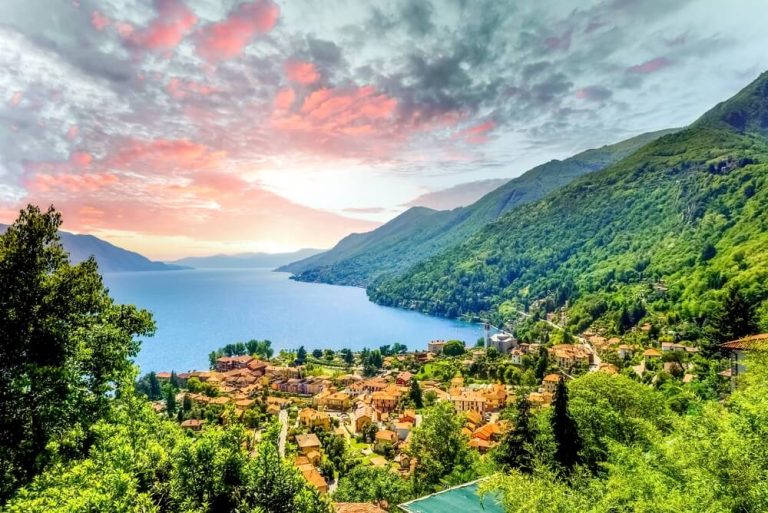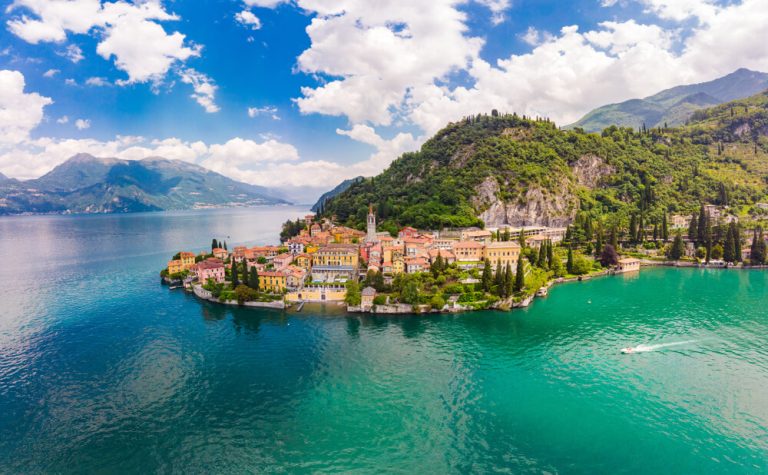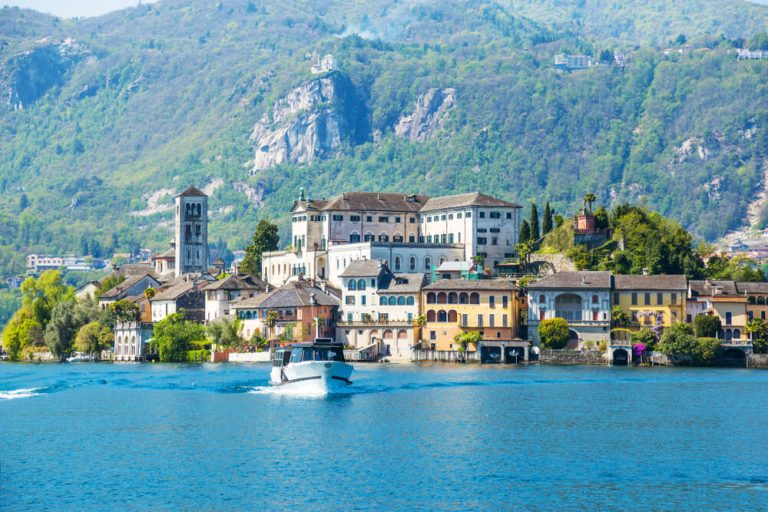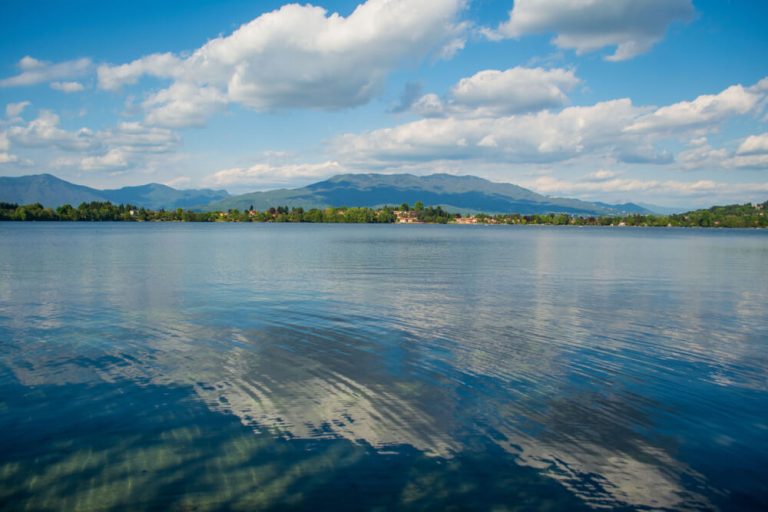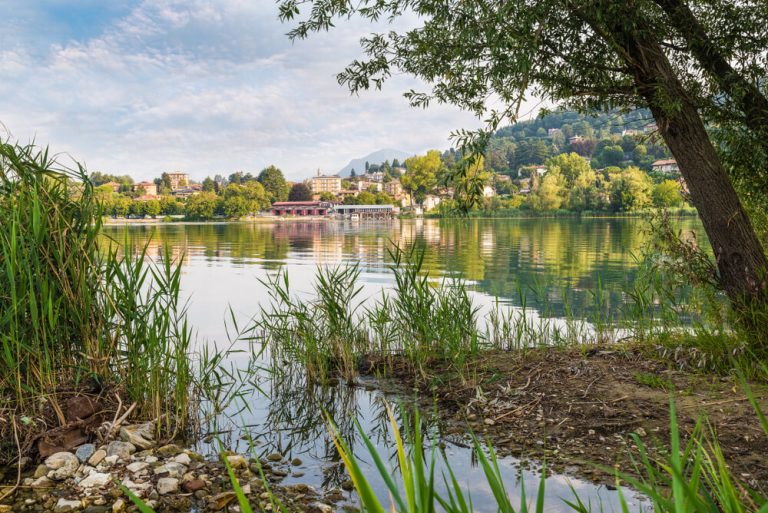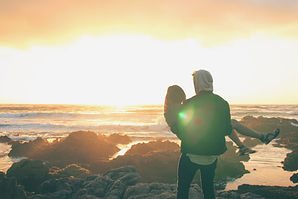Italian Lakes
Travel Guide
Everything you need to know
Where are the Italian Lakes
The Italian Lakes region is in the north of Italy (although it is important to note that the lakes are also partly located in southern Switzerland). They sit south of the Alps in the basin of the River Po. There are a number of lakes. The most popular are Lake Garda, Lake Como and Lake Maggiore. However, Lake Iseo, Lake Lugano, Lake Orta, Lake Varese, Lake Monate and Lake Idro are also lesser-known lakes that can make an interesting holiday destination.
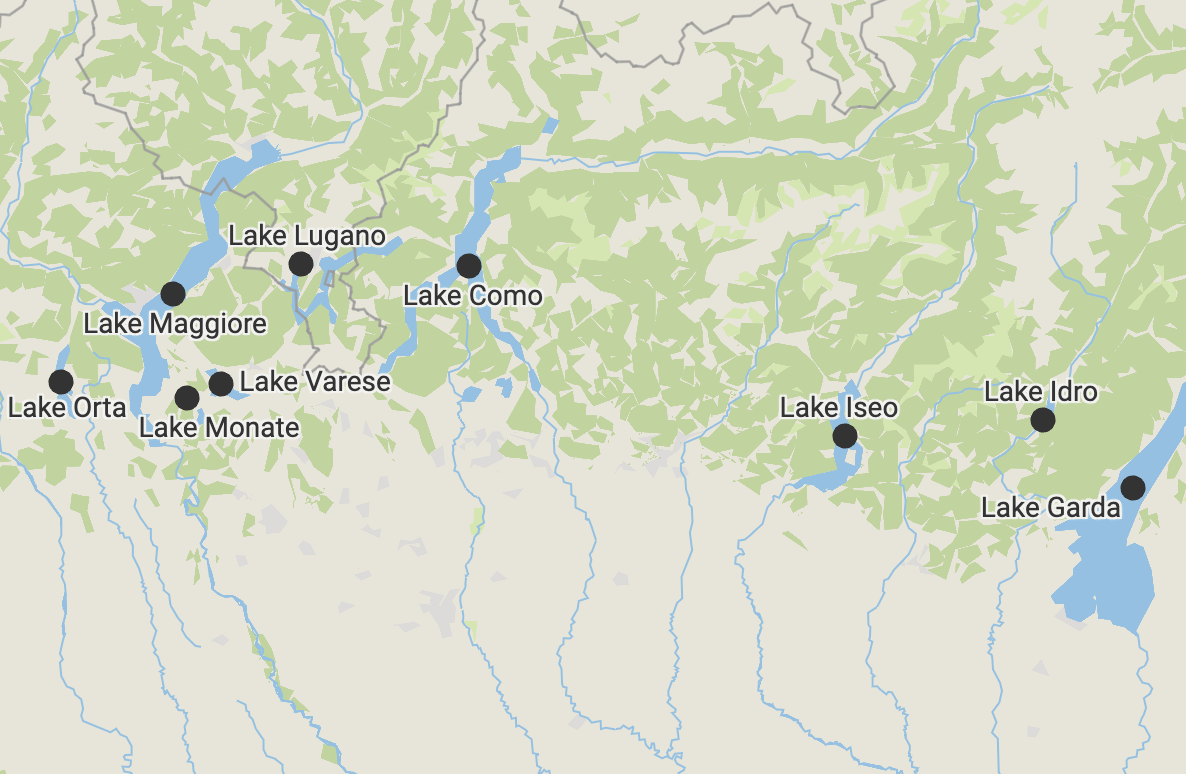
The lakes cover a large area and are not restricted to just one region of Italy. In fact, their shores span a number of different regions including Lombardy, Piemonte, Trentino-Alto Adige and Veneto.
Lake Maggiore is the longest of the Italian Lakes measuring approximately 65 km. It straddles both Switzerland and Italy. In fact, 15% of it is in Swiss territory. In contrast, more than 60% of Lake Lugano falls into Switzerland. Lake Como can lay claim to being the deepest of the lakes. The lake has two arms, one leading to Como and the other to Lecco. Lake Garda is the biggest lake. Unlike Lake Como and Lake Maggiore, it has no significant islands to speak of, although it does have a handful of small islets. Lake Orta is tiny in comparison, measuring just 13.5 km long and 2.5 km wide at its widest point.
Because of the sheer size of the area, the Italian Lakes is a very diverse landscape. Each lake has its own unique characteristics. For example, Lake Como is famous for its steep forested slopes which rise up dramatically from the lake waters, nestled next to which sit beautiful villas and gardens. The largest of the Italian Lakes, Lake Garda has everything from water sports to Medieval castles to discover. Lake Maggiore has charming lakeside villages to discover and is home to the Borromean Islands. Lake Iseo is much more of a hidden gem in Italy. It is home to Monte Isola which is Europe’s largest lake island. And Lake Orta is a peaceful and tranquil gem.
How to get there
Because the Italian Lakes are located across such a wide area, there are a number of ways to get there. Whether you want to come by plane, train, car or bus, we have got you covered!
By Plane
If visiting Lake Garda, then you have a couple of options. You could opt to fly into Venice Marco Polo Airport. This sits approximately 150 km to the east of Lake Garda. However, if flights allow, the nearest airport would actually be Verona Villafranca Airport (VRN). Sitting just south of the lake, this is just a 20 minute drive from Peschiera del Garda and 30 km from Sirmione, both key towns on Lake Garda. Ryanair, Easyjet and British Airways all fly here from the UK.
However, Verona airport would not be convenient for visiting all the other Italian Lakes. In this case, there are other, more convenient options to choose from.
Milan Bergamo Airport (BGY) might also be convenient if planning a Lake Garda villa holiday. After all, it’s just over an hour’s drive from the airport to Lake Garda’s western shores. However, Milan Bergamo is definitely most convenient for those visiting Lake Iseo. It is less than 50 km from Iseo itself or just 30 minute drive from the south east shores of the lake at Sarnico. Milan Bergamo is also a good option for those planning a Lake Como villa holiday as it is just 40 km from the airport to the southernmost tip of Lake Como at Lecco. If you don’t mind a longer transfer time, it’s even a good choice for those heading to Lake Maggiore too. It can take less than 90 minutes to reach the popular Lake Maggiore lakeside town of Arona from Milan Bergamo airport and it’s only 100 km from Lake Varese too.
However, if visiting Lake Maggiore, Lake Varese or even Lake Orta, Milan Malpensa airport (MXP) would be the closest option to choose. You can get to Lake Maggiore from Milan Malpensa airport in as little as 30 minutes. If you’re dependent on public transport, you can use the Alibus bus shuttle service from the airport to connect you to the western side of Lake Maggiore. Please note that this route is seasonal, running from April to October, and tickets must be pre-booked. At under half an hour, the journey time to Lake Varese from Milan Malpensa is even less, whilst to Lake Orta it’s still under an hour. Milan Malpensa is also convenient for those headed to Lake Como too. The main town of Como is less than 50 km from the airport.
Closer to Milan itself is Milan Linate airport. Like Venice Marco Polo airport in the east, this can offer a wider choice of flights for international travellers. It’s approximately an hour by car from Milan Linate to Lake Como, Lake Iseo, Lake Maggiore and Lake Varese, whilst Lake Orta is still less than 90 minutes away.
Lake Iseo is also served by another small airport – Verona Brescia (VBS). Ryanair fly into this airport from the UK. With a transfer time of just 40 minutes from here to Iseo, it is super convenient.
Finally, another couple of airports people often forget to consider are Turin and Bologna (BLQ). Whilst over 150 km south of the Italian Lakes, the journey time by car from Bologna to Lake Garda is still comfortably less than 2 hours. And Turin is just 130 km from Lake Maggiore.
All these airport options mean holidaymakers have plenty of choice. Milan is also a major global hub for not just tourism but also business and trade. This means that there is a high frequency of flights in and out of its airports too. And all this choice and competition between airlines on these routes means that flight prices can often be much more reasonable than to other cities in Italy.
By Train
Italy is one of the most rail-friendly countries anywhere in the world. Some of Europe’s most impressive and scenic train journeys cross over its borders from countries in the north. For example, the route through the Brenner Pass links Munich with Venice. There are also fast train services between Paris and Milan. Once arriving in either Venice or Milan by train, it’s then easy to go on to reach the Italian Lakes.
If heading to Lake Como, you can catch a direct train from Milan Centrale to Como San Giovanni, getting you to the lake shores in under 50 minutes. This is Como’s main train station and it also has direct connections to some major Swiss cities such as Lugano or Zurich. A journey from Como to Zurich will take just 2.5 hours and there are approximately 10 direct trains a day on this route.
Similarly, you can easily catch a train from Milan Centrale to Stresa, the main town on Lake Maggiore. The journey will take just over 50 minutes. From here, the public boat network can take you to the other towns and villages on the lake. There are also slower, regional trains which will take longer but which offer a cheaper alternative. Trains also run from Milan to other towns on Lake Maggiore including Arona, Verbania, Calde, Luino and Locarno.
For those looking to travel to Lake Orta by train, this lake has a handful of train stations around its shores – Omegna, Pettenasco, Orta Miasino and Gozzano. However, there are no direct trains from Milan to Lake Orta. Instead, you will need to change trains at Novara. It is important to note that at Orta San Giulio, the station (Orta Miasino) is almost a 30 minute walk to the historic centre of the town and lakeside. Much of this route follows a lakeside path so it is an enjoyable walk but not perhaps quite so much fun if you have a lot of luggage!
Finally, to get from Milan to Lake Iseo, first take a train from Milan to Brescia and from here change to a regional train to Iseo itself. You can then once again use the ferries to reach the other towns on the lake. Alternatively, the Brescia-Iseo-Edolo train line operated by Trenord, also stops at the following towns on the eastern shores of Lake Iseo – Sulzano, Sale Marasino, Marone and Pisogne. The regional trains that go along this line also pass through a few additional stops such as Pilzone, Vello and Tolline. However, you won’t find any trains running along the western shores of the lake.
It’s easy to get to Lake Garda from Milan and the journey is extremely picturesque. The main train stations on Lake Garda are those at Peschiera del Garda and at Desenzano del Garda-Sirmione. Both are at the southern end of the lake. Fast trains take between 50 minutes and an hour and run up to 25 times per day. If you’re wanting to reach the northern part of Lake Garda, then you will need to buy a ticket to Rovereto. From here, it’s a bus ride to the lakeside. Riva del Garda is 45 minutes by bus and Torbole 35 minutes. There are no other train stations on Lake Garda so, once there, use the boat or bus network if using public transport.
There are two main train operators in Italy. These are the state run Trenitalia and privately owned Italo. Both provide super-efficient high-speed rail links between major Italian cities. In the Italian Lakes, you will also come across a couple of other operators. SBB is Swiss Federal Railways. They operate long distance trains between Switzerland and Italy, including routes to Milan. The S30 route connects Milan airport with Bellinzona via Laveno and Luino on Lake Maggiore. And there is also Trenord.
Trenord focuses on regional and local services, and is particularly strong in the Italian Lakes region. For those landing at Milan Malpensa airport, Trenord runs the Malpensa Express. This is a service that runs from Milan Malpensa airport terminals 1 and 2 to both Milano Cadorna and Milano Centrale Stations. Trains depart every 30 minutes. Trenord’s trains reach speeds of between 130 and 160 km per hour. Their trains usually have two different classes – first and second. First class will give you a more spacious seat and additional amenities that second doesn’t offer.
By Car
If you are coming to the Italian Lakes from outside Italy, then there are three main points of entry into Italy by car. These are the Mont Blanc tunnel from France, the Grand Saint Bernard tunnel from Switzerland and the Brenner Pass from Austria. However, you also enter Italy from Switzerland via the Simplon Pass. This historic road sits further east in the Alps but will take you all the way from Switzerland to Stresa on Lake Maggiore.
Wherever you choose to cross the border into Italy, there is a good road network in Italy. To get from A to B quickly, then use the Italian Autostrada where possible. These are fast roads which you pay to use. Toll booths will either require immediate payment or ask you to take a ticket. In this case, payment will be made when you exit the motorway. Payment can be made by credit card or in cash. Just make sure you choose the correct lane – telepass or biglietto. The telepass will automatically deduct the toll from your bank account. But the likelihood is that you won’t have one of these devices fitted. Instead, opt for taking a ticket (biglietto).
Fun fact: Italy was the first country in the world to build motorways. And the first ever motorway to be built was the Autostrada dei Laghi back in 1924. This connects Milan to both Lake Maggiore and Lake Como. It now forms the A8 and A9 motorways. You can also take the A26 motorway from Milan to Sesto Calende to access the eastern shore of the lake. The main east west link road from Lake Garda in the east to Lake Maggiore in the west is the E64. There is also a fast road – the A22 – that runs east of Lake Garda from north to south. You can check real time traffic information and journey times using the network of Italian autostrade here.
Once near the lakes, roads can often be narrow and winding. This can mean that driving around the lake can be slow-going. In some areas, roads can also be steep.
By Bus
It’s not often we recommend using the bus over the train, but if you are landing at Milan Malpensa airport and need to get to Lake Maggiore using public transport, than the Alibus is also a great option. The bus must be pre-booked and is seasonal, usually operating between April and October each year. It collects from both terminals at Milan Malpensa airport and stops at a number of lakeside villages including Stresa, Arona, Lesa, Belgirate and Pallanza.
Likewise, if you land at Milan Malpensa and want to get to Lake Como, then Flixbus offer a regular service between the airport and the lakeside. Flixbus have a number of routes throughout Italy, including a route from Venice airport to Peschiera del Garda so it’s worth looking at their site for options.
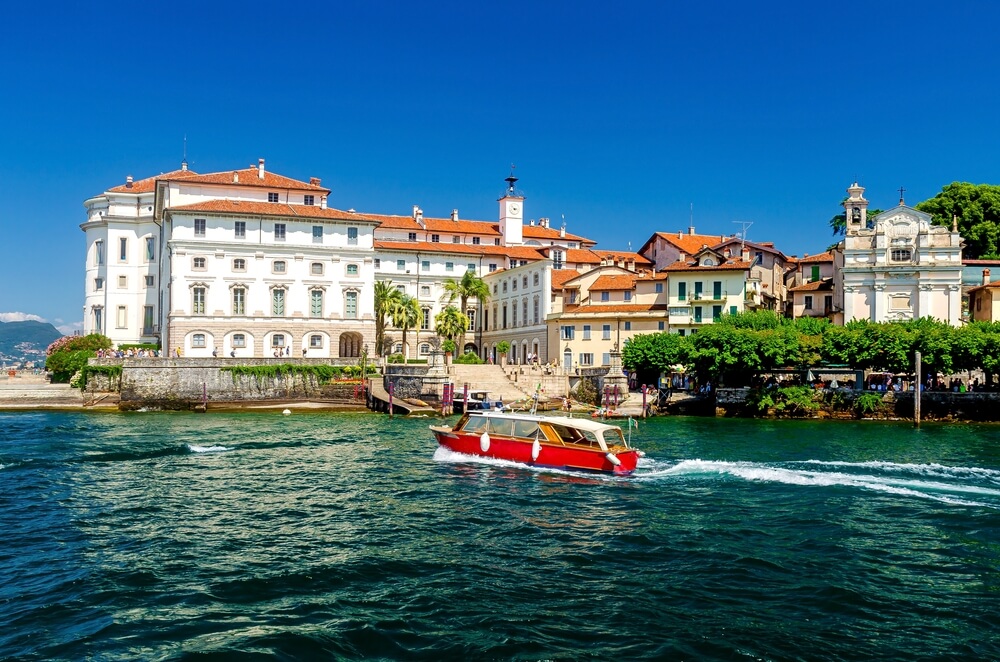
How to get around the Italian Lakes
We think that the best way to get around the Italian Lakes is to use a combination of transport options. A car isn’t always essential but we do usually recommend having one, even if it’s parked up for large parts of your Italian Lakes villa stay. But you can also use a combination of boats, buses and trains too. Trains tend to connect major towns whilst the ferries are typically great for reaching the smaller towns and villages.
Public Transport
The easiest and most popular way to explore each of the Italian Lakes is by boat. All the large lakes – Garda, Como and Maggiore – have an excellent public ferry service that criss-crosses the lake all day long. Timetables can be viewed at Navigazione Laghi.
There are three types of boat. The first – battello – is a great option for tourists. It is the slowest option. But these boats have an outside deck and provide the opportunity to simply savour the wonderful lake views you can enjoy en route. The second is the hydrofoil (aliscafo). This is a much faster service. And finally, there are traghetti (car ferries). These allow you to travel with your vehicle across the lake. On Lake Maggiore, this runs throughout the year from Intra to Laveno and on Lake Garda from Maderno to Torri del Benaco. In the Summer time, there is also a car ferry on Lake Garda between Limone and Malcesine. On Lake Como the car ferry runs between Bellagio, Menaggio, Varenna and Cadenabbia.
Lake Orta also has a daily public boat service which stops at Orta San Giulio, Isola San Giulio as well as the charming villages of Pella, San Filiberto, Lagna and Omegna. On Thursday, it’s market day at Omegna and on this day, there are additional services from many of other lakeside villages. These include L’Approdo, Pettenasco, Giardinetto, Crabbia, Ronco and Oira. The Lake Orta boat timetable can be viewed here.
You won’t find a boat service on smaller lakes such as Lake Varese or Lake Monate. It is also important to note that the frequency of boats will vary significantly in low season versus peak season.
Trains serve some areas in the Italian Lakes but certainly not all. For example, whilst it is easy to get to Como by train, if travelling onwards up the lake from there, then there are no other train stations on the western branch of Lake Como. Travelling by train along the eastern branch of Lake Como is easier. A train route goes from Milan through Lecco, Varenna and Colico. As a result, if you’re needing to get up the lake to towns such as Bellagio or Menaggio, you can catch a train from Como to Varenna-Esino and then catch the boat from here to your final destination. Alternatively, when arriving in Como by train, you have the option of using the public boat network from Como to get you from A to B.
On Lake Maggiore, both sides of the lake are covered by railway lines. That on the eastern Lombardy side is the Milan-Luino line. On the west Piedmont side, it’s the Milan-Domodossola line.
On Lake Garda, the two main train stations in the south of the lake are Desenzano and Peschiera del Garda. In the north, it’s Rovereto. However, most of the smaller towns and villages either don’t have train services at all, or are potentially better served by buses.
Travelling by bus is also often a cheap mode of travel if you’re on a budget. Just be aware that they are not always particularly frequent and the timetable will vary from Winter to Summer. What is more, it can be confusing working out what buses are running and when. This is in part because there is no national bus network in Italy. Most buses are regional. And, even within the same region, there can sometimes be multiple companies operating.
The main bus companies in the Italian Lakes are V.C.O. Transporti Srl and S.A.F. Srl. To take Lake Maggiore as an example, V.C.O. has five main routes here. Route one operates between Omegna and Verbania, line 2 is an urban line in Verbania and line 3 runs from Verbania to Brissago in Switzerland via Cannobio. You then also have line 4 between Verbania and Piancavallo and line 5 from Verbania to Mergozzo and Domodossola. S.A.F. has suburban services on a couple of key routes. The first goes from Verbania to Milan via Baveno, Stresa and Arona. The second is the Valgrande line stopping at Verbania, Aurano, Caprezzo, Cossogno and Intragna and Miazzina.
If opting for the bus on Lake Garda, line 27 (LN027) runs along the entre western coast, linking Desenzano to Riva del Garda. The same is true on Lake Como, where it will be the C30 (Como to Bellagio via Nesso) and C10 (Como to Colico passing through Tremezzina and Menaggio) routes that will be most helpful.
Information about buses online is generally limited and not particularly user friendly. You may also find that services are much fewer at the weekend than on weekdays. And they may well not operate at all on public holidays. If you’re already in Italy, you may want to visit the bus station in person to check timetables and book tickets. Or you can book tickets online via Omio.
Alternatively, bus tickets in Italy can now be purchased online at Trainline. Bus tickets in Italy typically go on sale about three months before the date of travel. Booking early will ensure you take advantage of the cheapest fares.
Renting a car and driving
There are a number of benefits to driving a car in the Italian Lakes. Not least, it allows you to explore this region at your own pace. It also enables you to fully discover the smaller picturesque lakeside towns and villages and get into the hills and mountains round about. We do recommend if renting a car that you do so at the airport. Apart from in the larger lakeside towns, it’s not easy to find a local car rental office and rental prices are usually at a premium when hiring lakeside versus at the airport.
There are two types of main roads in the Italian Lakes – the motorway (autostrada) and the state roads (superstrada). The autostrada are toll roads indicated by green signs. The superstrada are indicated by blue signs and are free to travel on. The A8 and A9 are known as the highways of the lakes, since they provide access to the large lakes of Northern Italy including Lake Como and Lake Maggiore. The A8 links Milan with Varese and the A9 Milan with Como.
Many of the smaller streets around the Italian Lakes are narrow and don’t provide much room for cars to pass. As a result, don’t hire a vehicle bigger than you need. And, if parking on the roadside, we recommend you put your wing mirrors in to minimise the chances of damage to your vehicle. Be prepared for twists and turns and even hairpin bends, particularly on the hillsides around the lakes. And expect plenty of tunnels! Italian law requires all vehicles to keep their dipped headlights on even during daylight hours when driving outside urban areas, including on motorways. When in the Italian Lakes, we advise you keep them on dipped all the time, just in case you come across a tunnel or two!
Drivers should also be aware of Zona Traffico Limitato (ZTL). These restricted traffic areas prohibit non-resident vehicles from entering. The aim behind them is to reduce pollution and limit damage to streets and buildings in the historic centres. In reality, whilst they may cause stress to some drivers, they have also managed to create a much nicer experience for those exploring these historic centres on foot. The ZTL tend to be active during certain hours so you need to read the signage carefully.
Every entrance to a ZTL will be clearly signed indicating that you are entering a restricted traffic area. These signs consist of a white circle with a red border on a white background. The words ‘Zona a Traffico Limitato’ is clearly written above the circle, whilst below there will be information regarding the timing that the restrictions are in place. For example, a sign stating 9.00 – 18.00 would indicate that the restrictions are in place between 9 o’clock in the morning and 6 in the evening. Your rental car will not have a permit to access these areas. Nor will your own vehicle. The only exception will be if you have booked accommodation within a ZTL and your accommodation provider has already informed you that you are able to enter the area and have already taken a note of your car registration plate. If in doubt, check with them before entering.
Don’t be tempted to enter if you happen to see other vehicles inside the area. Residents are normally allowed to enter as is public transport. And don’t be fooled by what your GPS or SatNav system might be telling you to do either. Sadly, they’re not always that smart and don’t always inform you that you’re entering a restricted traffic zone!
Bellagio on Lake Como, Stresa and Cannobio on Lake Maggiore, Bardolino and Lazise on Lake Garda and Orta San Giulio on Lake Orta all have ZTLs in place. As do other lakeside towns. Entrances will also be marked by security cameras. These will immediately record your registration number if you enter and a fine will be issued should you be breaking the restrictions.
However, most towns have clear parking areas outside these ZTL areas. We find that parking is relatively straightforward (albeit you may sometimes need to be a little patient to wait for a space to come up). For us, the exception is when it’s market day in a town. It can then be super difficult to find somewhere to park up. Instead, on these days, we recommend you opt to arrive by boat or public transport if you can.
Wherever you choose to park, don’t leave any valuables on display. Whilst Italy is a safe country, you should avoid leaving items on display that might tempt someone to break in. Even when at the service station, make sure your car is locked when heading inside to pay. And, if you can possibly avoid it, don’t even leave valuables locked in the boot.
Taxi
There are private taxi companies which offer connections from the airport to your Italian Lakes accommodation. There are also services such as FreeNow and Uber on some of the lakes, but not all. On Lake Como, there are a couple of main taxi companies – Radio Taxi Como being one. Similarly, on Lake Maggiore there are a few taxi companies you can find online via their website – Taxi Stresa Matteo for example. The same is the case with Lake Garda. However, generally, once at the lake, don’t expect to be able to get a taxi easily. Book ahead.
It is also possible to hire a private taxi boat to explore the lake. On Lake Maggiore, there is Lago Maggiore Boat which offer a water taxi service as well as tours. Similarly there is Lake Como Water Taxi on neighbouring Lake Como (amongst others) and Danieli Taxi Service on Lake Garda. Certainly, a water taxi is a very elegant and glamorous way to get from A to B. In peak season it can also mean you can avoid any congestion on the lakeside roads (particularly on Lake Como which can get really snarled up). Just make sure you check the price beforehand.
Cities and Towns in the Italian Lakes
With so many lakes covering such a wide geographical area, it would be impossible to list all the cities, towns and villages in the Italian Lakes here. But these are what we would consider the principal, most famous ones.
Milan
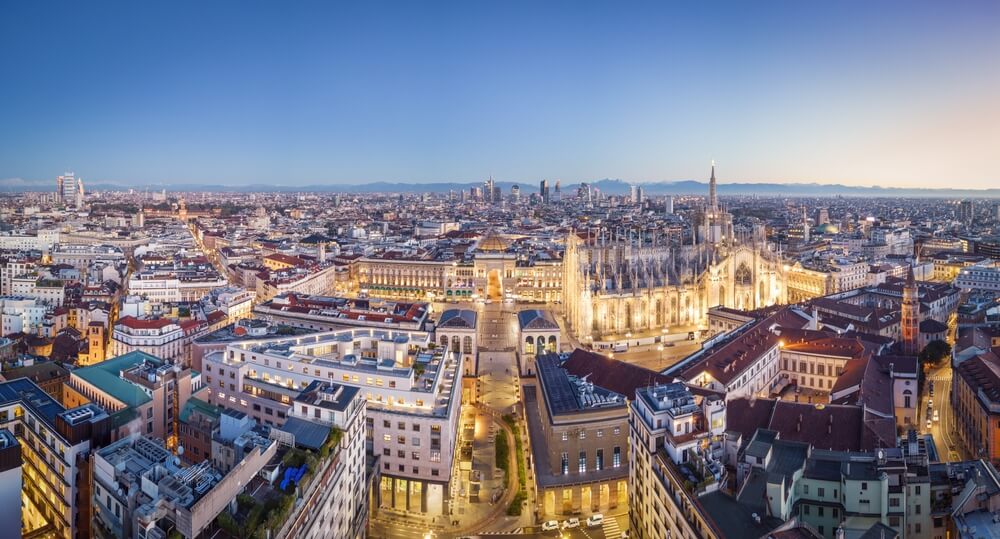
Introduction to Milan
Often referred to as the ‘gateway’ to the Italian Lakes, Milan is the second most populous city in Italy. It is a global design and fashion capital, hosting both a Spring-Summer and Autumn-Winter fashion week. However, it can also boast a rich history. Home to iconic landmarks such as the Duomo, the Galleria Emanuele II, the La Scala opera theatre and the Sforzesco Castle, it is a centre of art and culture.
Milan is also home to one of the world’s most famous paintings – Leonardo da Vinci’s The Last Supper – which is kept in kept in the Convent of Santa Maria delle Grazie. This is certainly not the only painting of note in the city. The Sforzesco Castle in Milan is home to several of Milan’s museums including the Pinacoteca which houses a superb collection of Italian paintings and sculpture. Or, for more modern artworks, head to the Museo del Novecento in the Piazza del Duomo. This museum is home to a wealth of twentieth century Italian art, including works by Picasso, Kandinsky and others.
With just as much to see and do indoors as there is outdoors, there are plenty of things to do in Milan when it rains.
Tips for navigating the city
Milan is an easy city to navigate thanks to a super efficient public transport system. The city has not only an excellent bus network but also has a tram and subway service too.
The metro system in Milan is often the quickest way to get around the city. It has five different lines: M1 (red line), M2 (green line), M3 (yellow line), M4 (blue line) and M5 (lilac line). In addition, it also has the Milan Passante railway. This is an underground railway which has just 6 main stops in the city – Porta Vittoria, Dateo, Repubblica, Porta Venezia, Porta Garibaldi and Domodossola.
Milan subway trains run as often as every few minutes during rush hour. Tickets can be purchased in the metro station at an ATM ticket machine. Before getting on the train, validate your ticket and then go through the turnstile. The ticket is then valid for 90 minutes after stamping. Tickets must also be validated when leaving the station.
Children under the age of 14 years old are able to travel free of charge with an accompanied adult.
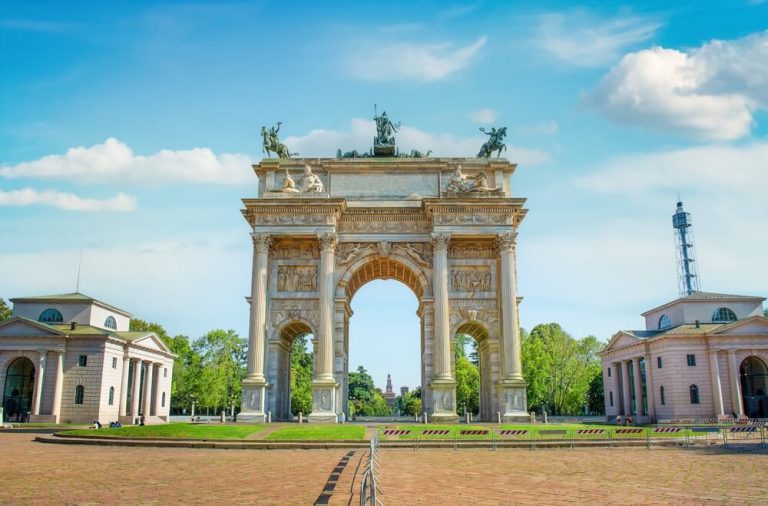
The trams and buses also provide a wide range of routes throughout Milan. These can also be a better way to see more of the city, especially if moving between different neighbourhoods.
If you are in Milan for a few days, a good option is to purchase a Yes Milano City Pass. This official city pass will give you 3 days of unlimited travel on trams, buses and metro lines (zones M1-M3). It also provides access to a number of Milan’s top attractions, museums and landmarks, enabling you to skip any ticket lines.
Taxis are readily available in Milan. And finally, there is BikeMi. This is a public bike sharing system which allows you to pick up and return bikes at any of the 325 designated stations around the city. Both traditional bikes and e-bikes are available.
Accommodation and dining recommendations
It is well worth spending 48 hours in Milan to do justice to the city. The good news is that there are plenty of accommodation options if you do want to stay overnight including plenty of Milan hotels,
Our favourite wine bar in the city is Cantine Isola. You’ll be mixing with the locals here. If you can’t find somewhere inside to sit, grab a crate and just sit in the street outside!
Milan is packed full of superb restaurants. If you are looking for fine dining, then there are well over a dozen restaurants in Milan with Michelin stars.
For the best steak in Milan, we recommend you head to Varrone. Or for a unique dining experience, you can’t beat tucking into the Spider Crab Vermicelli at La Granseola.
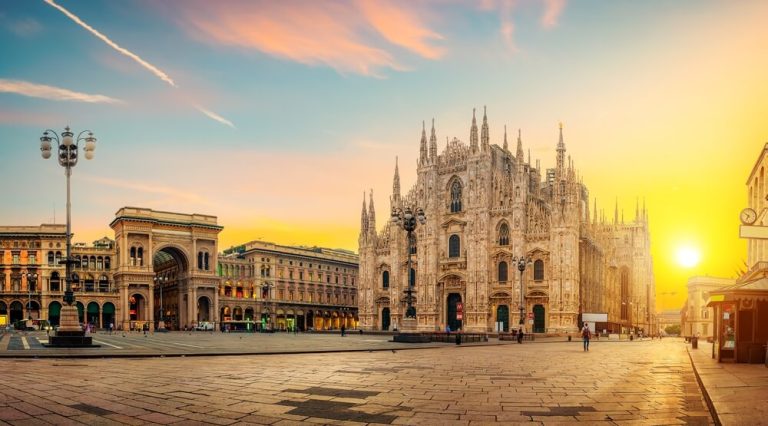
Verona
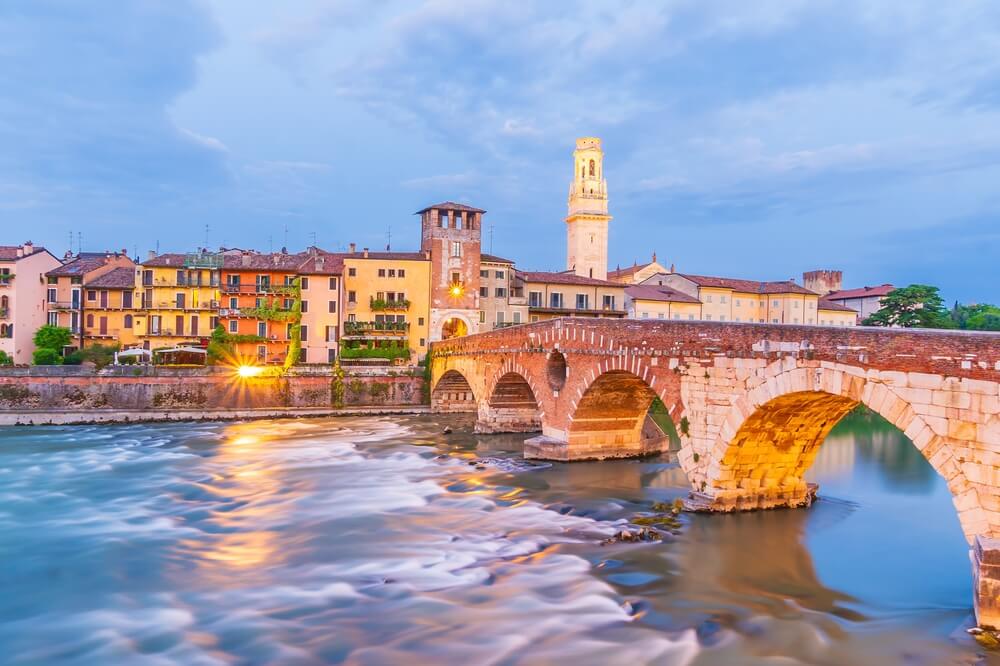
Introduction to Verona
There is little not to like about Italy’s most romantic city, Verona. One of Italy’s UNESCO World Heritage sites, it is home to a rich collection of Roman remains as well as some incredible examples of Romanesque, Medieval and Renaissance art and architecture too.
The Piazza Bra is Verona’s largest square and is where you will find the Arena di Verona. This is the third largest Roman amphitheatre in Italy, behind the Colosseum in Rome and the amphitheatre in Capua. If you can, visit during the Summer annual opera festival to view one of the performances that still take place there. It is an incredible experience. This square is also a great place to grab a coffee at one of the many bars and cafes that line it and just enjoy a spot of people watching!
The other main square in Verona is the Piazza delle Erbe. This sits on the site of what would have been the old Roman forum. Important buildings line each side of the piazza. These include the ancient town hall – Torre dei Lamberti – along with the Casa dei Giudici, the Casa Mazzanti, the Palazzo Maffei and the Casa dei Mercanti (House of the Merchants). In the centre of the square is a fourteenth century fountain atop which sits a much earlier statue dating back to 380 AD called Madonna Verona.
Of course, when in Verona, paying a visit to the balcony of Romeo and Juliet at the House of Giulietta is also a must. And to get a great view of Verona, climb the 368 steps on the spiral staircase to the top of the 84 metre high Torre dei Lamberti (or use the glass elevator instead)!
Tips for navigating the city
Much of Verona is a ZTL (Zona a Traffico Limitato) where access by car is severely restricted. As a result, it’s worth leaving your car outside the city and get about on foot or using public transport. It’s certainly easy to walk between Verona’s attractions as the city is relatively compact.
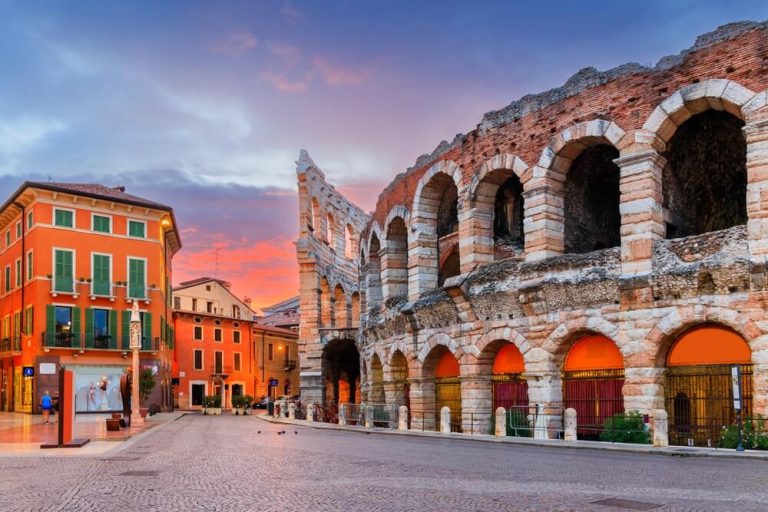
However, should you want to use public transport, buses run from 5 in the morning until midnight. You can buy tickets for single journeys. Or, alternatively, you can purchase 1, 3 or 7 day passes for unlimited travel.
We recommend investing in a Verona Card. You can opt for a card that is valid for either 24 or 48 hours. This will give you unlimited free travel on the ATV transport system as well as free or reduced entrance tickets to dozens of Verona’s museums and attractions.
An eco friendly alternative to the buses is to travel by bike. You can either hire bikes in the city or use Verona Bike. This allows you to pick up and drop off bikes at any of the many stations dotted around the city.
Accommodation and dining recommendations
Whilst Verona is a great city for a day trip, to do justice to the city, it’s worth staying for at least one night. Two days provides more than enough time to see everything in Verona’s central area, although admittedly three days would allow you to view it all at a more relaxed pace.
If you can, we recommend you stay in the historic centre of Verona. The good news is that there are plenty of accommodation options there including plenty of Verona hotels. However, if you’re only in the city for a night, you may also want to consider staying near the train station. This is only just outside the historic centre and so a short walk will get you to all the main attractions. At night, this area is also a little livelier with plenty of restaurants and bars so may suit a younger traveller. Alternatively, if you’re travelling to Verona on a budget, look for accommodation in Veronetta, the university district. Or, if you’re after the most authentic feel to your stay, head across the Adige River to the San Zeno district. Less visited by holidaymakers, it has a quieter, more peaceful vibe.
Visitors to Verona are spoiled for choice when it comes to eating out. The city is packed full of excellent restaurants.
Breakfast in Verona is sweet – the Veronese definitely like to start the day with something sugary. Otherwise, at lunch and dinner, you will find frequently find risotto on the menu. It’s worth sampling the Risotto all’ Amarone. Made using the local red wine, the result is a vibrant shade of purple packed with flavour.
For the ultimate foodie experience in Verona, and to experience the warmth of Italian hospitality, book dinner with a local.
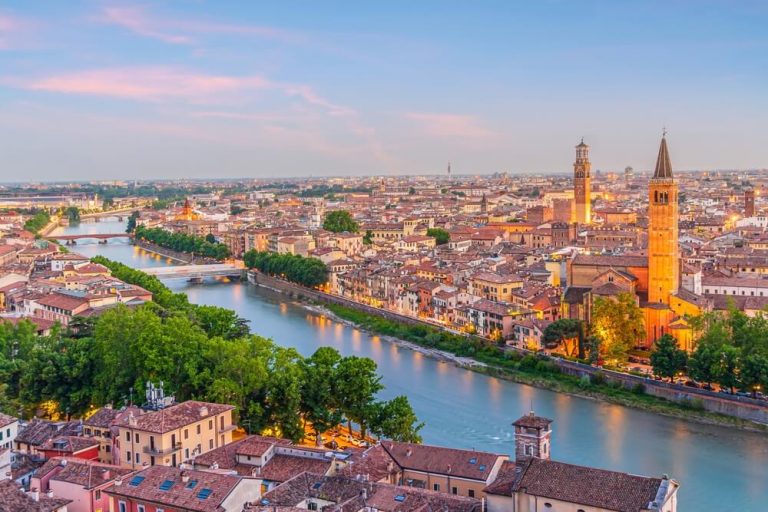
Stresa
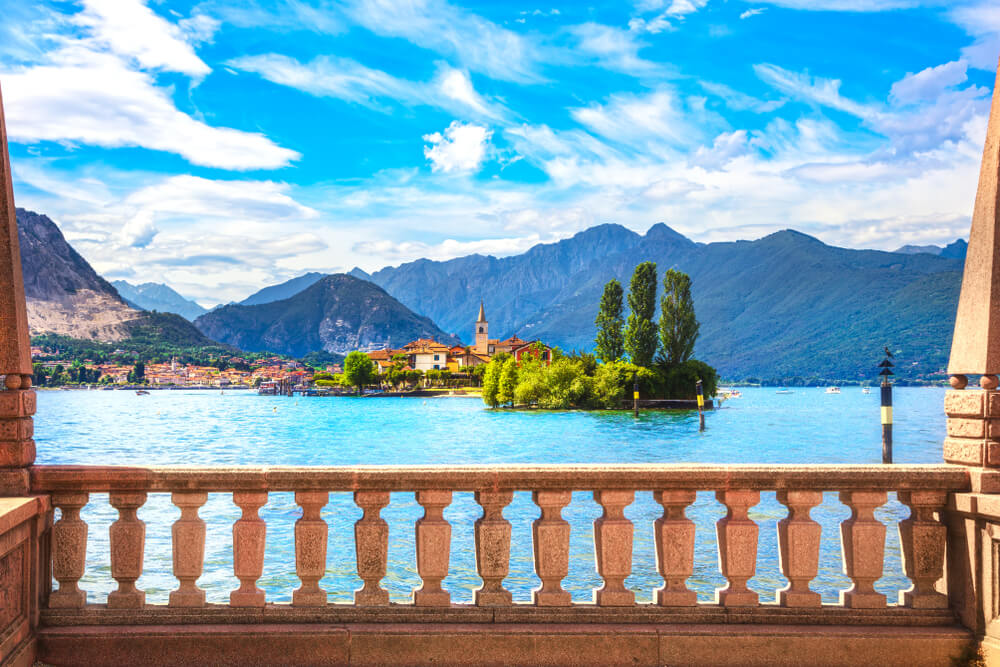
Introduction to Stresa
Stresa is Lake Maggiore’s most famous lakeside town. It has attracted writers and artists since the era of The Grand Tour of the mid nineteenth century. It is a town that is easy to explore on foot. And, in fact, if you are a keen hiker, there are some longer routes that can be enjoyed that take you beyond Stresa itself. One lovely walk is the Chestnut Route. The walk takes approximately 2.5 hours but takes you to some of the small hamlets between Stresa and nearby Belgirate. You can then return to Stresa by either boat or train.
Stresa is also a great base from which to explore the beautiful Borromean Islands – Isola Madre, Isola Bella and Isola Pescatori. Of these, only Isola dei Pescatori is inhabited. It was traditionally home to the lake’s fisherman. Even today, it’s still home to some of the best fish restaurants in the area. The gardens of Isola Madre and Isola Bella are stunning, especially in the Spring when the azaleas, camellias and rhododendrons are all in full bloom. Keep an eye out for the famous white peacocks on Isola Bella and the budgerigars flying above you on Isola Madre.
Isola Bella is also home to a beautiful 17th century Baroque palace that was built on the orders of Carlo III for his wife, Isabella d’Adda. Much of the palace is open to visitors and it’s definitely worth enjoying a tour of its splendid rooms and grottoes.
Back on the mainland in Stresa, there are also other incredible villas to admire. Many of these are now upmarket hotels such as the Grand Hotel des Isles Borromees where the author Ernest Hemingway once stayed.
Tips for navigating the city
Stresa is a town that is easy to explore on foot. And, in fact, if you are a keen hiker, there are some longer routes that can be enjoyed that take you beyond Stresa itself. One lovely walk is the Chestnut Route. The walk takes approximately 2.5 hours but takes you to some of the small hamlets between Stresa and nearby Belgirate. You can then return to Stresa by either boat or train.
Alternatively, head to the Mottarone mountain that sits above Stresa to enjoy hiking or skiing (dependent on the season)! Here, on a clear day, you can enjoy one of the most beautiful sights of any of the lakes – 360 degree views from the Po Valley to the summit of the Alps with views of 7 lakes – Lake Maggiore, Lake Orta, Lake Mergozzo, Lake Varese, Lake Comabbio, Lake Monate and Lake Biandronno. You can walk all the way back from the summit to Stresa, stopping at the Alpine Gardens half way down. It will take you about 4 hours to complete
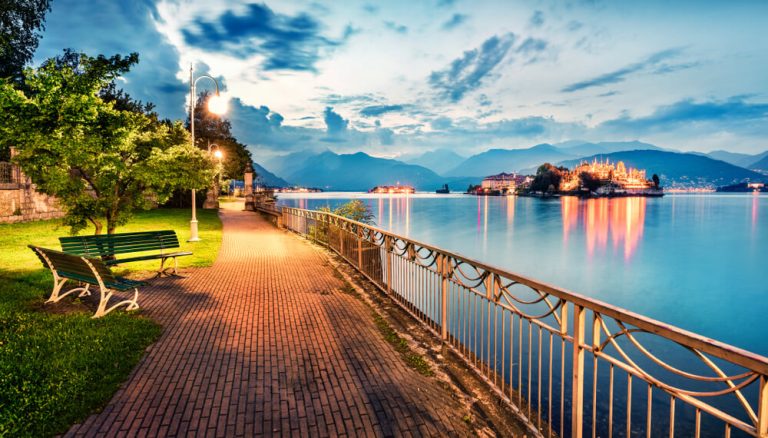
Accommodation and dining recommendations
If staying overnight in Stresa, there are plenty of accommodation options on offer, suitable for all budgets. These include hotels in Stresa, B&Bs as well as Stresa apartments too. Just be aware that, whatever option you choose, you will need to pay a tourist tax. In Stresa, the tourist tax applies to all accommodation but the amount depends on the type and rating of your hotel or holiday rental. Typically, costs are between €1 and €2.50 per person per night. Wherever you stay, you will also need to provide a copy of the ID document of each person in your party.
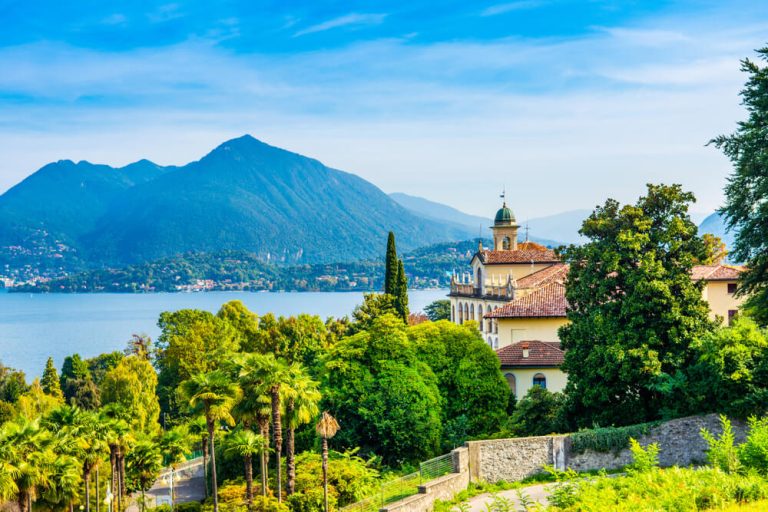
It’s certainly worth staying in Stresa long enough to enjoying lunch or dinner if you can. One of our favourite eateries in Stresa is Il Vicoletto, a popular restaurant tucked away in Stresa’s narrow streets. Alternatively, head to Il Clandestino, a fine dining fish and seafood restaurant. For superb fish dishes, another option is to head to Il Verbano, a Michelin star restaurant on Isola dei Pescatori.
Whilst Stresa is the most well-known of any of the towns on Lake Maggiore, it is by no means our favourite. Instead, that accolade would go to either Canobbio or Cannero, both much more hidden gems on Lake Maggiore. Discover all the Lake Maggiore towns and villages here.
Como
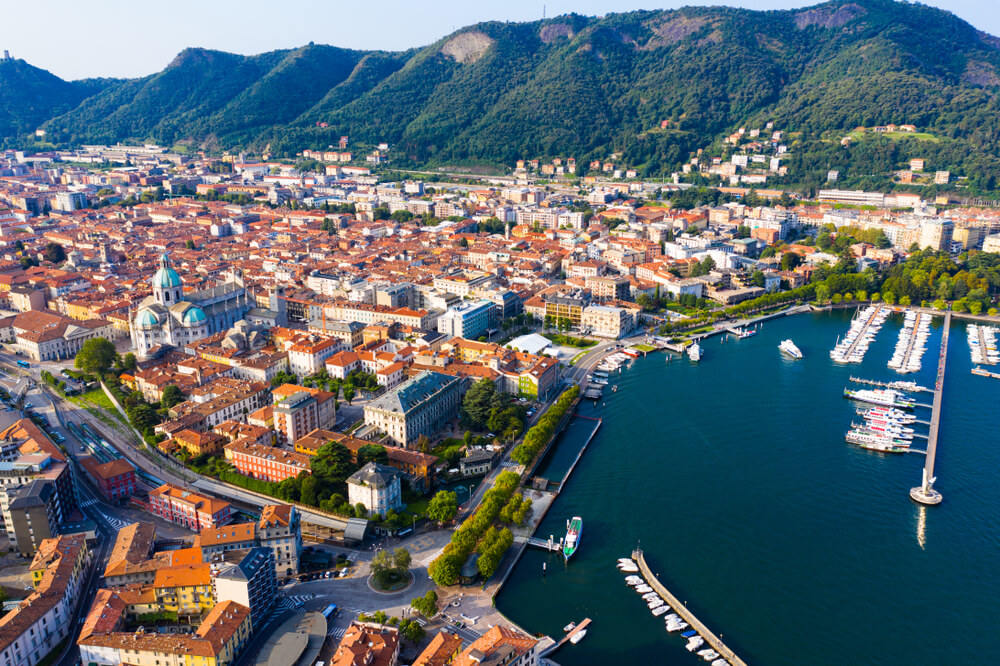
Introduction to Como
Como is Lake Como’s largest town and sits at the southern tip of the lake. Like Stresa, it was a favourite stopping point on the Grand Tour of centuries ago. These days, it boasts a long lakefront promenade which passes through one of the town’s main squares – the Piazza Cavour. This is where you will also find the Teatro Adriano and Chiesa Valdese. This isn’t the only church in Como worth visiting. Also of note is the Cattedrale di Santa Maria Assunta along with the smaller Basilica di Sant’ Addondio, with its blue and gold ceiling.
What we love to do most in Como is to simply wander through Como’s charming streets. It’s a popular shopping destination and there are some lovely independent shops and boutiques here. It is possible to trace the origins of Como’s silk industry back to the fourteenth century. But it was in the eighteenth and nineteenth centuries that the silk and textile industries were at their peak here. Whilst the industry may have waned since then, Como is still a great place to shop for these items.
For those visiting Como in the hot Summer months, there is also a lido in town – Lido Villa Olmo. This has lake access as well as a swimming pool and extensive areas simply for sunbathing and relaxing. There is also a popular beach bar and café.
Tips for navigating the city
Como is an easily walkable city, with many attractions within a pleasant stroll of one another. Of course, should you need to use it, there is a bus service too. Buses in Como are run by ASF Autolinee. They boast a fleet of eBus electric buses which are both comfortable and quiet. They have both urban services within the city and extra urban lines to take passengers from Como to other towns and villages on the lake. The main bus station is in Piazza Matteotti. However, some of the extra urban lines will also stop at the train station. Purchase tickets online at DropTicket.
Como also boasts a more unusual mode of transport. Anyone visiting for the first time should set aside time to take the 7 minute funicular ride from the lakeside at Como up to the village of Brunate. Once at the top, there is a café where you can enjoy a drink whilst admiring the views down over Como and across the lake. We also recommend you make the effort to walk the 20 minutes from the summit to the Volta lighthouse. Volta was the inventor of the electric battery. He was born in Como and, despite his international fame, returned to the town to continue his research until his death in 1827. The lighthouse is amazing and the 360 degree views from it are magnificent.
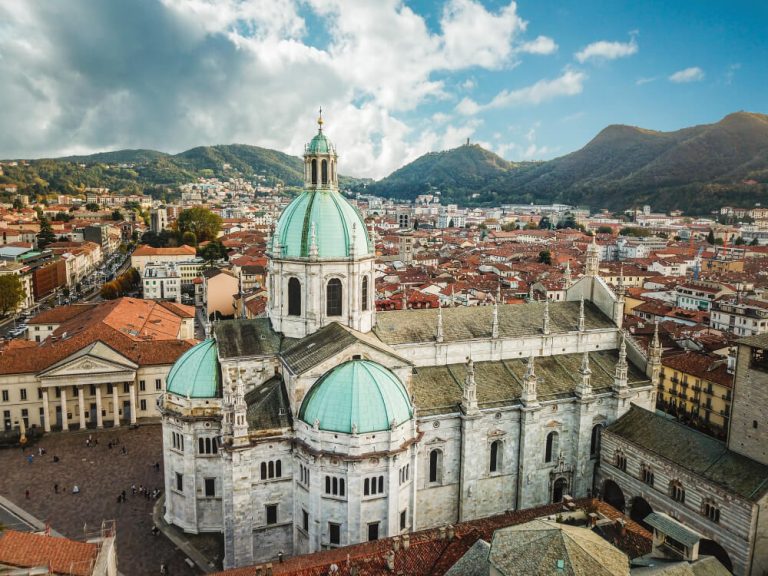
Accommodation and dining recommendations
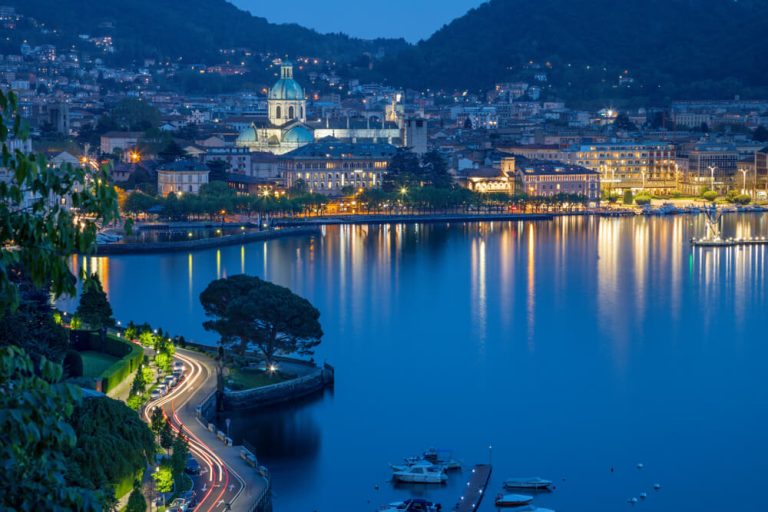
There are plenty of accommodation options in Como. These include hotels in Como, B&Bs as well as Como villa rentals too.
If you spend an evening in Como, try and time it so that you can enjoy a performance at the Teatro Sociale. It’s an absolutely beautiful setting to enjoy the opera. Combine it with dinner at one of Como’s many restaurants. Kitchen Como is a 1 star Michelin restaurant and one of our favourite places to eat in Como. We always love La Cava dei Sapori.
Bellagio
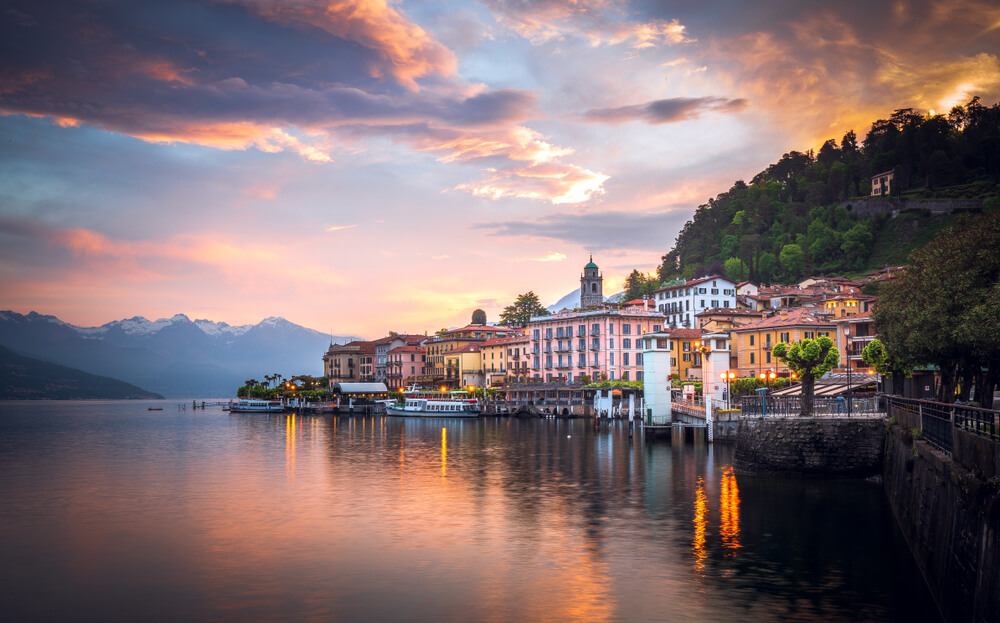
Introduction to Bellagio
Bellagio may not be Lake Como’s biggest town but it’s definitely its most famous! Known as ‘the pearl of Lake Como’ it boasts some impressive lakeside villas which have magnificent gardens open to the public – Villa Melzi and Villa Serbelloni (now a hotel). It also has a charming historic centre, characterised by narrow cobbled streets, alleyways and piazzas. Window boxes are festooned with flowers and it is certainly rather idyllic, albeit frequently too busy for our liking. Sadly, Bellagio’s popularity has brought with it boatloads of holidaymakers which, at times, overrun the town.
To escape, we recommend heading just out of town. A pathway and steps take you uphill from Bellagio to the nearby picture postcard fishing village of Pescallo. It’s a world away from the crowds of Bellagio and a great viewpoint. Alternatively, whilst no guide to the Italian Lakes could exclude Bellagio. if you want to avoid the crowds and tourist traps, perhaps consider visiting neighbouring Varenna instead. Use our guide to the towns of Lake Como to discover more about Varenna and all the other lakeside villages.
Tips for navigating the city
On a practical level, we don’t recommend you come by car to Bellagio if you can avoid it. Parking can be extremely tricky, certainly between April and October. And the historic centre is a fully pedestrianised ZTL area. Instead, come by boat if you can.
Once in Bellagio, the town can easily be explored on foot. However, Bellagio is renowned for its narrow cobbled streets and uneven staircases. These are charming and add to its character but may cause difficulty for those with mobility issues. It is worth heading to the upper part of the town if you can though – the views over Lake Como get more magnificent the higher you go.
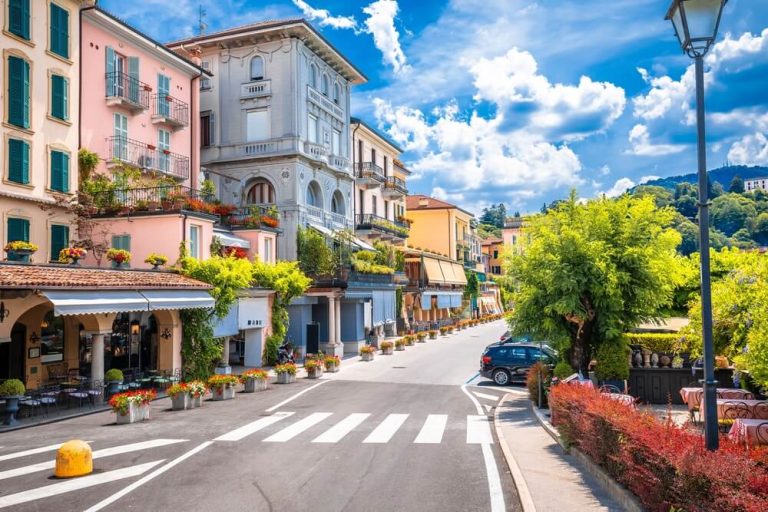
Accommodation and dining recommendations
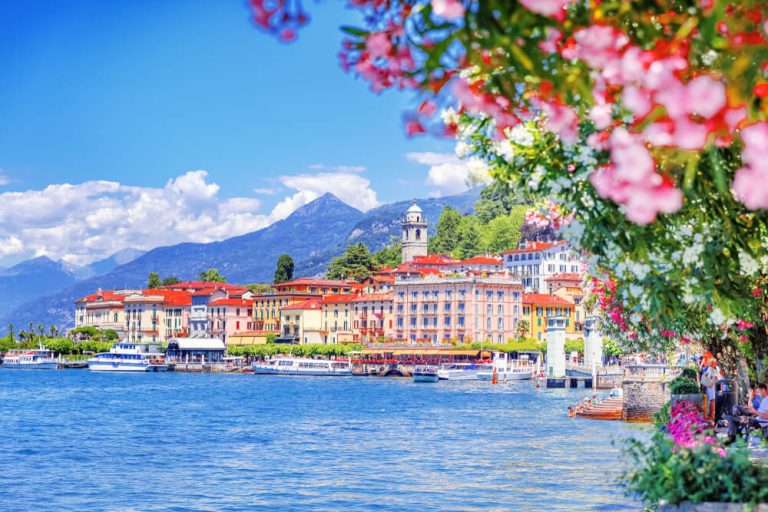
There are a wide variety of accommodation options in Bellagio. These include grand hotels in Bellagio such as Villa Serbelloni to more intimate, family run B&Bs. Alternatively, you could opt for a luxurious Lake Como villa rental instead. These usually provide more space and privacy for holidaymakers and can be a particularly good option for families.
Even if you’re not staying in Bellagio, if you have time to eat out here, then our favourite restaurant is definitely Salice Blu. The food here is contemporary Italian. Each course on their five and seven course tasting menu seems to get better and better, just when you thought it was impossible to do so. And, if you’re stuck for a taxi back to your Bellagio hotel, they’re likely to find a waiter happy to chauffeur you home!
Orta San Giulio

Introduction to Orta San Giulio
The principal town on Lake Orta, Orta San Giulio is a gem. It is certainly among the prettiest of any of the towns in the Italian Lakes. Charming lanes and alleyways weave their way past Renaissance and Baroque art and architecture. Squares and streets are lined with delightful boutiques, cafes and stores. All seem to reach the main square – Piazza Motta – eventually.
From here, a short boat ride costing just 5 euros and taking less than 5 minutes will whisk you across to Isola san Giulio that sits just 400 metres from the shore. Whilst Orta San Giulio may be bustling with holidaymakers, a visit to the island will restore the peace and calm you may be pining for. The island is dominated by its twelth century Romanesque basilica, home to the crypt of Saint Giulio. A single path then takes you around Isola San Giulio. Known as the Way of Silence, signs posted at regular intervals share thoughts about the power of silence. It is amazing how quickly this overcomes any temptation to look at your phone. This is a very peaceful, tranquil and special place well worth experiencing.
Tips for navigating the city
Like Bellagio, Orta San Giulio is fully pedestrianised. However, there are plenty of well-signed car parks as you drive towards the town. You can then either choose to walk down to the historic centre from here – it will take less than 10 minutes – or you can catch the small tourist train that regularly runs between the two. If you have young children, they may well make that decision for you!
Orta San Giulio is actually a great town if you enjoy walking. As well as enjoying a stroll along the lakefront or in the centro storico, there are a number of walking routes to enjoy. These include walks that incorporate a visit to Sacro Monte di Orta, one of Italy’s UNESCO World Heritage sites. The site includes a series of 20 chapels, each depicting an event from the life of Saint Francis through art.
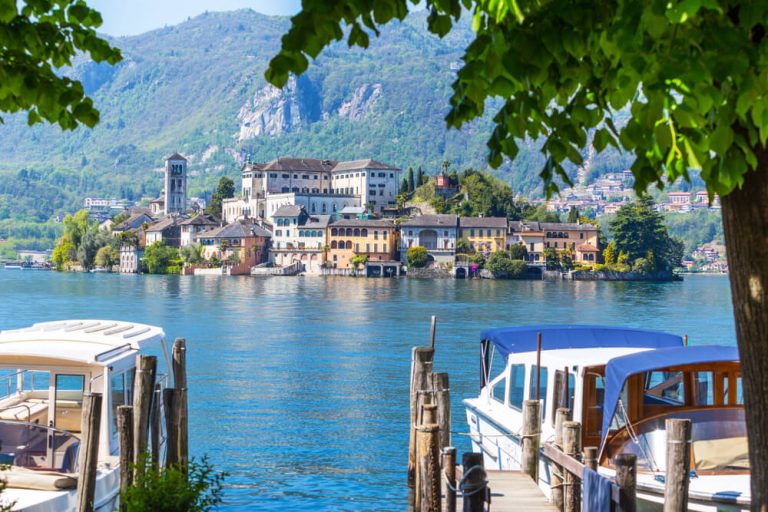
Accommodation and dining recommendations
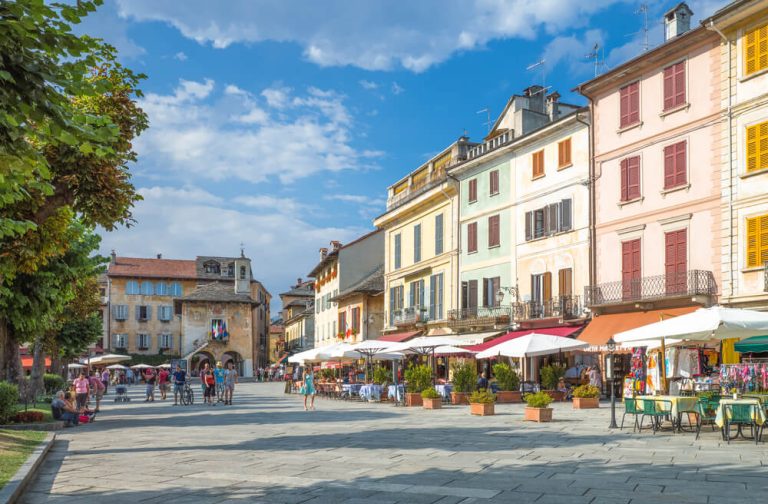
We definitely recommend spending a night in or near Orta San Giulio so that you can enjoy the atmosphere of the town when the majority of holidaymakers have headed home. The 3 star Michelin restaurant at Villa Crespi offers an exceptional fine dining experience. But there are plenty of more relaxed (and cheaper) options. A couple of our favourites include Ristorante Filo Fieno and Osteria San Martino which is actually a short drive from Orta San Giulio in the charming village of Crabbia. The restaurant is super traditional but serves up delicious food night after night.
If staying overnight in Orta San Giulio, there are plenty of accommodation options on offer, suitable for all budgets. These include B&Bs and hotels in Orta San Giulio as well as Orta San Giulio apartments too.
Riva del Garda
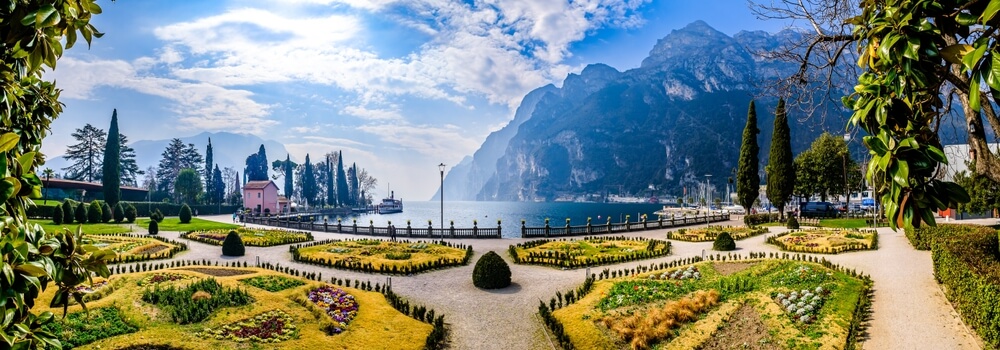
Introduction to Riva del Garda
Riva del Garda sits at the northern tip of Lake Garda, at the foot of the Dolomite Mountains. With a relaxed, laid back vibe, it’s a popular spot for windsurfers and sailors as well as those keen on hiking, climbing and cycling. It is a picture postcard town, full of charming, winding passageways and a glamorous lakefront promenade.
The central piazza – Piazza III Novembre – is the real heart of the town. Riva del Garda has a long and rich history, much of which is still evident today in the town’s buildings and in its museums. The original Medieval walls still enclose the old town and the 12th century fortress (rocca) also still remains standing. These days the rocca is home to the Alto Garda Museum. Here you can find exhibits of everything from palaeolithic archaeology to 19th century landscape paintings.
Close by is the 14th century Praetorian Palace and the slightly older Apponale Tower. An angel sits on top of the tower guarding the main square. Head 100 feet up to its terrace to enjoy breath-taking views of the lake.
Take a walk out of the town to enjoy more wonderful views from the Church of Santa Maria Maddalena and the Tower of San Giovanni which overlook the upper part of Lake Garda.
Malcesine
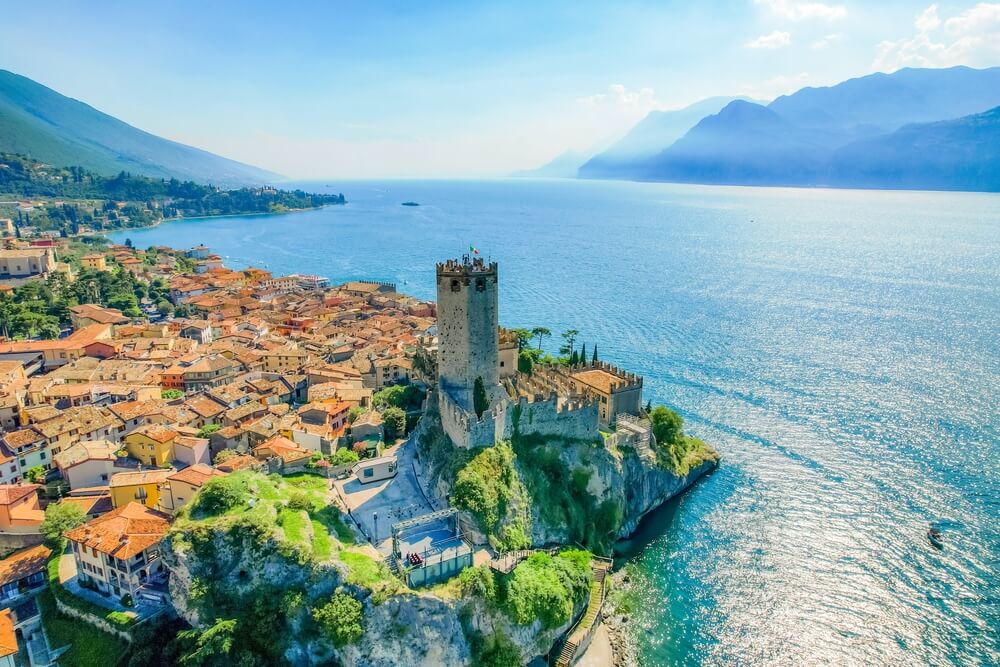
Introduction to Malcesine
Malcesine is a beautiful Medieval village nestled on the north eastern shores of Lake Garda and dominated by the Castello Scaligero. The castle is a subtle reminder of the incredible history of the region and the battles that would once have been fought to control this area. The charming cobbled streets below show no hint of the turmoil of the past though.
No visit would be complete without a trip up the cable car from the centre of the village up Monte Baldo. The first cable car takes you half way up the mountainside whilst a second, rotating cable car then takes you the rest of the way, allowing everyone to enjoy the views equally. Once at the top you can enjoy hiking in the summer and skiing in the winter. Sports enthusiasts can also enjoy some fantastic descents from the mountain top by bike. Or for those who prefer the lake, it’s one of the main spots for both sailing and windsurfing on Lake Garda too.
Things to do in the Italian Lakes
The Italian Lakes really do offer something for everyone. They are ideal for water sports enthusiasts, particularly windsurfers and sailors, due to the constant breezes and relative safety. Walkers will love exploring the lakeside towns and villages and the more serious hikers will be able to enjoy the higher slopes that enclose each lake. As you would expect, the Italian cuisine in the Italian Lakes is as good as any you will find in Italy. And there is plenty of beautiful architecture to admire too, whether it is the villas of Lake Como or church of Santa Caterina del Sasso that clings to the rocks of Lake Maggiore or the Roman remains in Brescia. And, of course, the nearby cities of Milan or Verona offer an abundance to see and do. Moreover, there are gardens in abundance for nature lovers to enjoy and admire. For us, Villa Carlotta on Lake Maggiore stands out as do the gardens on Isola Bella on Lake Maggiore. And can there be anything more romantic than taking a boat trip on any of the Italian Lakes? Few views can compete with that of Bellagio when seen from the water.
Art and Architecture
Lake Como’s lakeside villas have been used as the backdrop for numerous films over recent decades. For example, Villa del Balbianello was the location for scenes from the Bond film Casino Royale as well as the 2002 epic Star Wars: Attack of the Clones. This and Lake Como’s Villa Carlotta, Villa Olmo, Villa Serbelloni and Villa Melzi are all superb examples that depict the grandeur of an earlier age. And they are all fantastic examples of the incredible architecture of that era. The numerous villas built on Lake Como’s shores date from between the seventeenth and eighteenth centuries. However, there are later examples from the Art Nouveau period such as the early twentieth century Villa Oleandra.
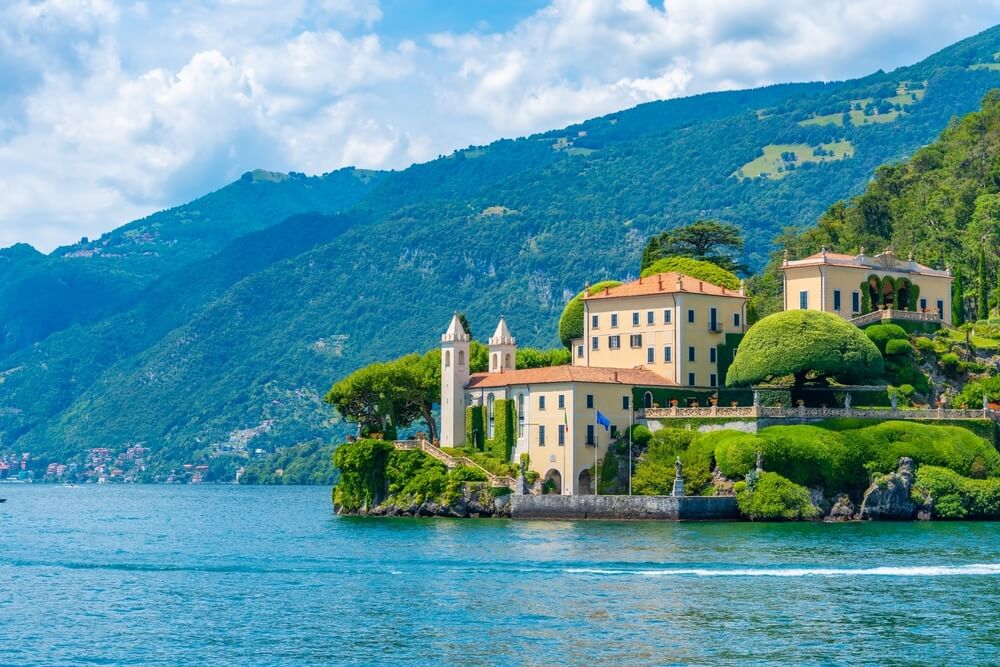
The Borromean Islands on Lake Maggiore are home to the most incredible Baroque Palace on Isola Bella. A tour will take you through rooms filled with priceless antiques and artworks. Likewise, the Palazzo Borromeo on Isola Madre is also home to an incredible display of furnishings and artworks from the family’s historic residences. There are other superb examples of architecture in other villas around Lake Maggiore. These include Villa Taranto, Villa Giulia and others. Also of note on Lake Maggiore is the beautiful Santa Caterina del Sasso monastery. This clings to the rocks and be reached either by road or boat. It contains some important frescoes that date between the 14th to 18th centuries.
Adding to the villas of Lake Como and Lake Maggiore are the castles on Lake Garda. Lake Garda has been at the crossroads of both trade and communication for centuries, so it’s perhaps not a surprise to see that rulers and nobility built castles to defend their territory and control resources. Some of the most significant include the Castello Scaligero in Sirmione as well as the Scaliger Castle in Malcesine. Also of note is the Castle of Torri del Benaco and the castles in Lazise and Padenghe.
And we must not forget the art and architecture of the principal cities within the Italian Lakes region. Leonardo da Vinci’s The Last Supper is on display in the Convent of Santa Maria delle Grazie in Milan. Likewise, in Verona, you can admire the incredible Arena di Verona, a Roman amphitheatre. Verona’s historic centre is, in fact, one of Italy’s UNESCO World Heritage sites and is home to an incredible array of architectural styles that date as far back as Roman times through to the Romanesque and Gothic eras and onto the Renaissance period. Brescia is also a UNESCO World Heritage site. It is where you will find the Castello di Brescia, whose architecture spans a number of historical periods, as well as the Renaissance Piazza della Loggia and not one but two cathedrals. It also boasts a number of superb art galleries as impressive as those in Milan.
Exploring the beautiful gardens
Not surprisingly, the lakeside villas in the Italian Lakes also boast just as exquisite gardens. You’ll need at least a couple of hours, if not more, to do justice to the incredible gardens at Villa Carlotta. These house an abundance of rare plant species within the 8 hectares of grounds. The intricate terraced gardens at Villa del Balbianello are just as exquisite. Alternatively, take a stroll through the Serbelloni Park gardens. The views of the lake are spectacular. Or opt for the gardens at Villa Melzi in Bellagio or those at Villa Cipressi in nearby Varenna which flow down to the lakeside.
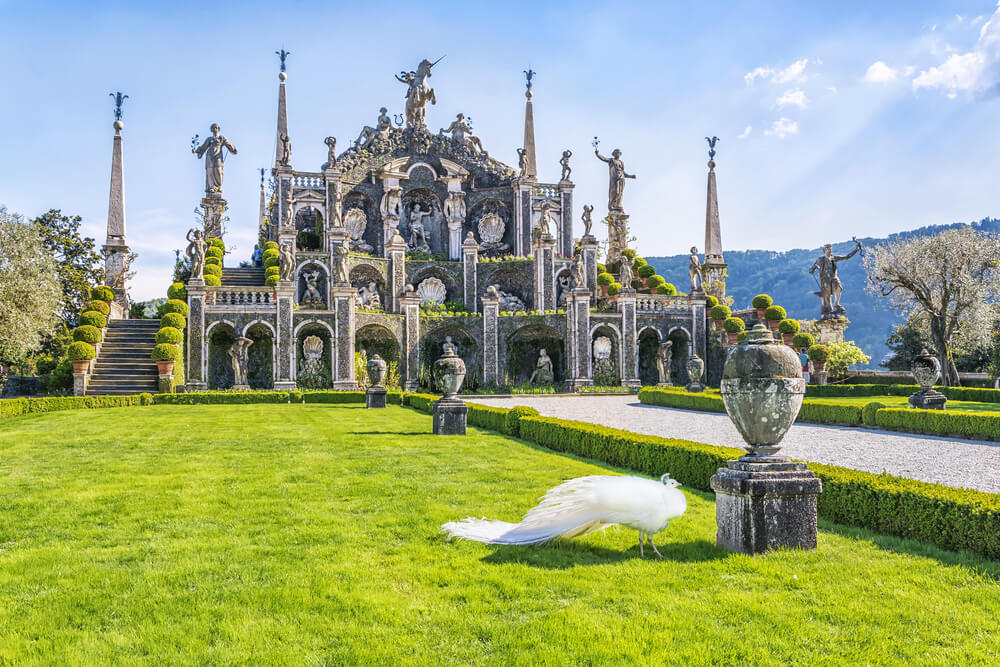
Rivalling these are the gardens of the Borromean Islands on Lake Maggiore. Here, the gardens on the beautiful Isola Bella are home to white peacocks. And at Isola Madre the 19th century English landscape garden is magical. Budgerigars will fly above you whilst you explore., walking among azaleas, camellias, rhododendrons, citrus trees and more. Visit in the Spring to marvel at the scala dei morti, a set of stairs covered in the most incredible wisteria. There are also beautiful gardens at Villa Taranto. We recommend you coincide your visit there with their Tulip Festival in the Spring. Or there are also the Alpine Gardens in Stresa along with the less well-known San Remigio Gardens.
Lake Garda is not as well-known for its gardens but there are still some impressive ones to explore on your next Italian Lakes villa holiday. For example, the arboretum at Arco has species originally planted back in the 19th century by Archduke Alberto of Habsburg including majestic holm-oaks, magnificent conifers and giant sequoia. Or on Isola del Garda the 19th century Venetian Gothic villa is surrounded by a beautiful natural park. Just be aware that to explore it you will need to book in advance through an authorised guide.
The smaller lakes can boast just as impressive gardens to discover. Our favourites include those at Villa Nigra in Miasino as well as the gardens at Villa Crespi. The latter is now a luxury hotel but it is possible to visit the grounds. The gardens at Villa Bossi in Orta San Giulio may be smaller but they are still charming, whilst the Italian style garden at Villa Bossi is rather romantic. Or, our final recommendation on Lake Orta would be the gardens at Villa Monte Oro in Armeno. Enjoy a long walk past colourful flower beds along the perfectly manicured lawns.
Vineyards and wineries
Wine making has a long history in the Italian Lakes region dating as far back as the Bronze Age. However, some of the Italian Lakes are known for their wineries much more than others.
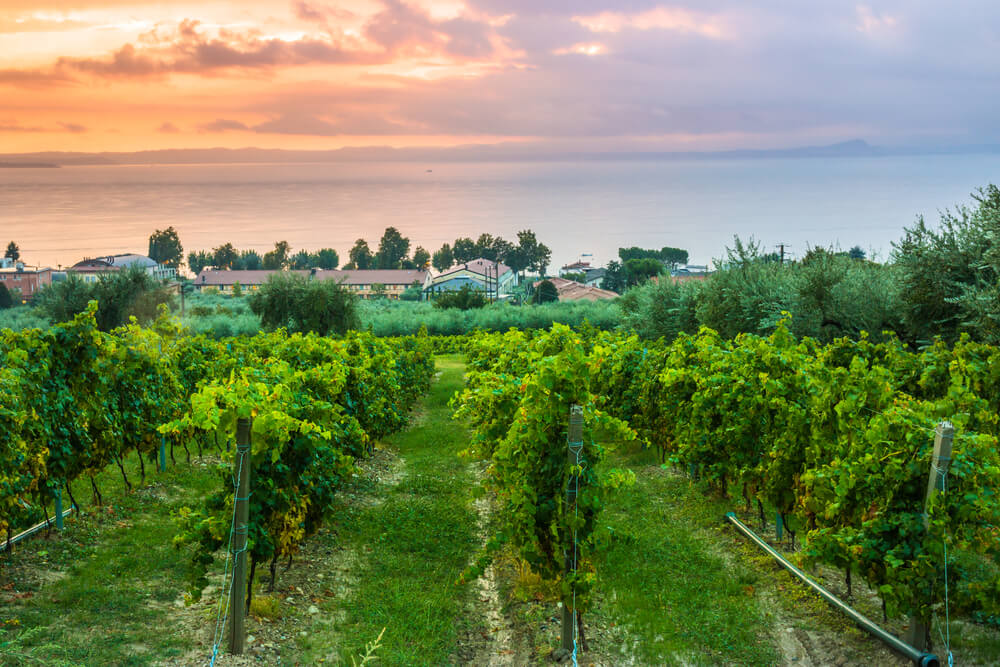
If you’re a keen wine buff, we would recommend you head to Lake Garda. This is where you will find the most wineries and the largest selection of wine. Wine is produced in the Bardolino hills to the east of Lake Garda. This is where you can enjoy Chiaretto rosato wines as well as Bardolino, a light red wine. In the south of Lake Garda, you then have the Lugana and Costoza white wines. And in the west you can enjoy Valtenesi and Riviera del Garda wines. But, by far the top red wine produced around Lake Garda is the very full-bodied Amarone della Valpolicella. It has a distinct aroma, created during the drying process – the grapes are dried for between 100 and 120 days in the ‘straw wine’ method.
Beaches
The pace of life in the Italian Lakes is slow and relaxed. In the Summer months, sightseeing can be easily interspersed with time spent on the beach and in the lake. The lake waters tends to reach an average temperature of between 20 and 22 degrees centigrade in July and August so it’s very pleasant for swimming.
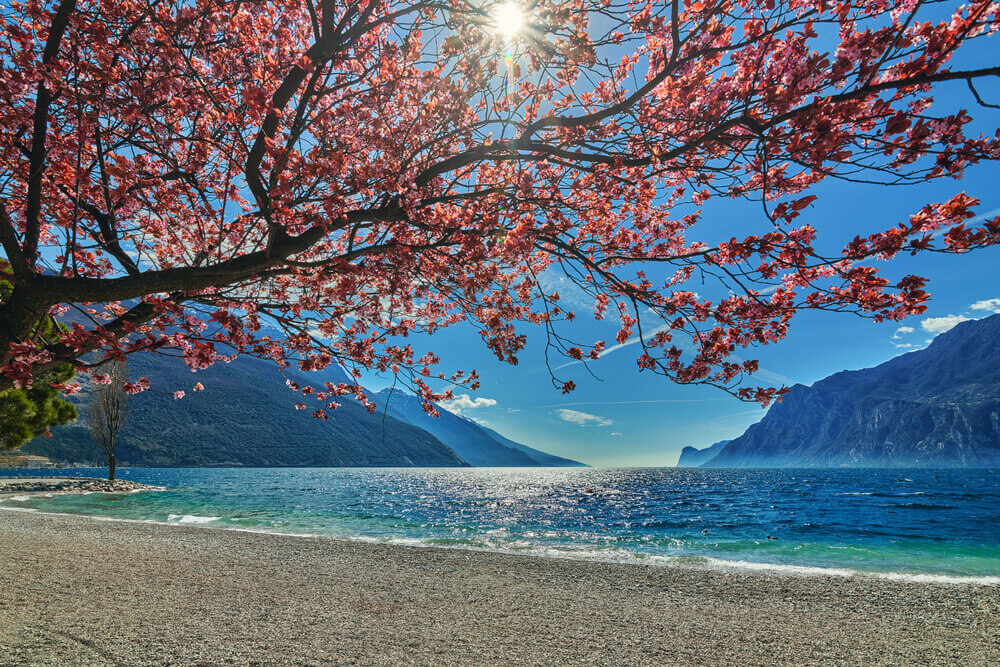
Lake Maggiore is dotted with small lakeside beaches. You can frequently park on the roadside and gain access to the lake. There are also larger beaches with car parking and other facilities such as volleyball or beachside cafes. And then there are lidos. Our favourite on Lake Maggiore is the one at Locarno in the Swiss part of the lake. As well as lake access, this boasts four outdoor pools, a diving pool, indoor pools, water slides and more. There are also lidos at Ascona and Baveno.
There are also some tiny beaches in the valleys leading down to Lake Maggiore – Valle Maggia and Valle Verzasca. Just a word of caution here – the currents can be extremely strong and the water icily cold in these hillside rivers so pay attention to any warning signs. That said, Valle Maggia is one of the few places you can actually find a sandy beach so if you have children with buckets and spades to use, this may be a good option.
Lake access isn’t necessarily so easy on all of the other lakes. On Lake Como, the position of private lakeside villas or grand lakeside hotels sometimes mean that getting to the lake water isn’t always as easy for the general public. You should also expect to find the water temperature in Lake Como cooler than that of the other lakes, due to the lake’s depth and chilly under currents. That said, there are still a few small pebbled beaches and a good number of lidos to be enjoyed. The most popular and well-known lidos include San Giovanni in Bellagio, the Lido di Ossuccio, the Lido di Lenno and the Lido di Cadenabbia which has a large swimming pool that sits over the lake. The lidos at Menaggio, Cernobbio and Bellano also have a pool as well as lake access. We also recommend you visit the enchanting spot at Nesso-Ponte della Civera – you may well recognise the bridge from photos. You can dive into the lake here and swim under the bridge for the perfect Instagram shot!
On Lake Garda, the beaches are more varied and there are a mix of sandy, pebbled and rocky beaches to enjoy. The landscape differs quite considerably from the south to the north of the lake too. Expect the water to be much more shallow in the south than the north too. Some of our favourite beaches on Lake Garda are Spiaggia Tufi in Limone sul Garda, the sandy beach at Lazise, the Jamaica Beach at Sirmione and the beach at Riva del Garda which is particularly popular with windsurfers.
Expect the same on the smaller lakes too. Lugano on nearby Lake Lugano also has a fantastic lido whilst Lake Monate has a number of both public and private beaches along its shores. Lake Orta has consistently been recognised in the top 10 cleanest beaches in Europe. Most of its beaches are smaller and pebbled. But some of the bigger beaches include the Lido di Gozzano and Spiaggia Miami. La Bagnera di Orta is popular thanks to its location in Orta San Giulio and we also recommend the Bagnella Beach in Omegna.
Water Sports
The pace of life in the Italian Lakes is slow and relaxed. In the Summer months, sightseeing can be easily interspersed with time spent on the beach and in the lake. The lake waters tends to reach an average temperature of between 20 and 22 degrees centigrade in July and August so it’s very pleasant for swimming.
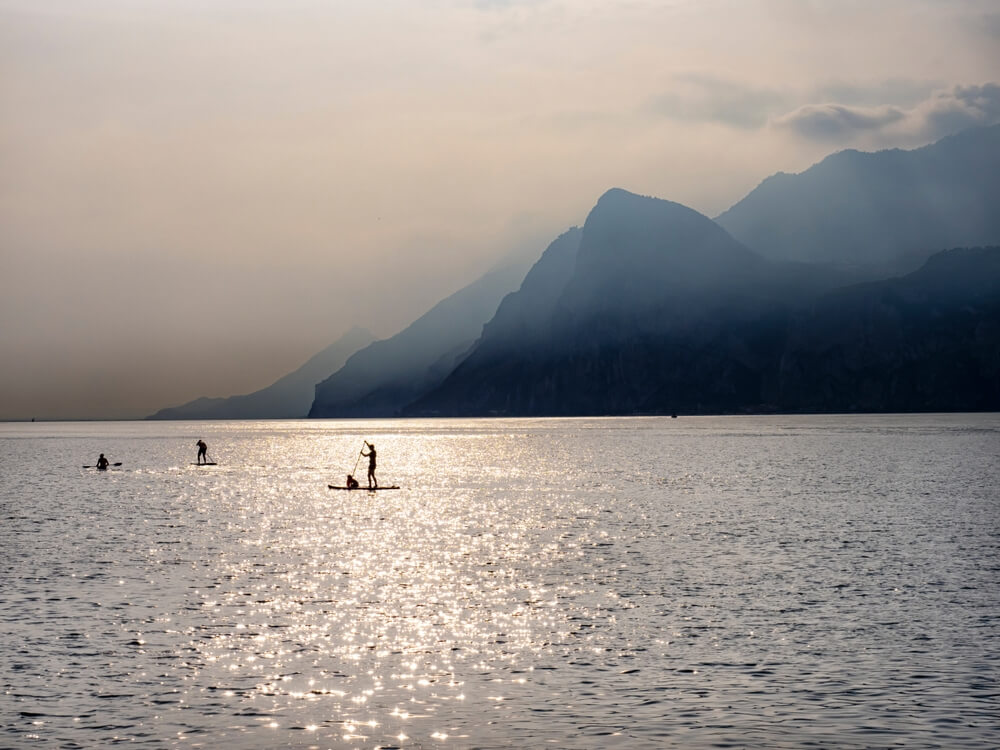
Lake Maggiore is dotted with small lakeside beaches. You can frequently park on the roadside and gain access to the lake. There are also larger beaches with car parking and other facilities such as volleyball or beachside cafes. And then there are lidos. Our favourite on Lake Maggiore is the one at Locarno in the Swiss part of the lake. As well as lake access, this boasts four outdoor pools, a diving pool, indoor pools, water slides and more. There are also lidos at Ascona and Baveno.
There are also some tiny beaches in the valleys leading down to Lake Maggiore – Valle Maggia and Valle Verzasca. Just a word of caution here – the currents can be extremely strong and the water icily cold in these hillside rivers so pay attention to any warning signs. That said, Valle Maggia is one of the few places you can actually find a sandy beach so if you have children with buckets and spades to use, this may be a good option.
Lake access isn’t necessarily so easy on all of the other lakes. On Lake Como, the position of private lakeside villas or grand lakeside hotels sometimes mean that getting to the lake water isn’t always as easy for the general public. You should also expect to find the water temperature in Lake Como cooler than that of the other lakes, due to the lake’s depth and chilly under currents. That said, there are still a few small pebbled beaches and a good number of lidos to be enjoyed. The most popular and well-known lidos include San Giovanni in Bellagio, the Lido di Ossuccio, the Lido di Lenno and the Lido di Cadenabbia which has a large swimming pool that sits over the lake. The lidos at Menaggio, Cernobbio and Bellano also have a pool as well as lake access. We also recommend you visit the enchanting spot at Nesso-Ponte della Civera – you may well recognise the bridge from photos. You can dive into the lake here and swim under the bridge for the perfect Instagram shot!
On Lake Garda, the beaches are more varied and there are a mix of sandy, pebbled and rocky beaches to enjoy. The landscape differs quite considerably from the south to the north of the lake too. Expect the water to be much more shallow in the south than the north too. Some of our favourite beaches on Lake Garda are Spiaggia Tufi in Limone sul Garda, the sandy beach at Lazise, the Jamaica Beach at Sirmione and the beach at Riva del Garda which is particularly popular with windsurfers.
Expect the same on the smaller lakes too. Lugano on nearby Lake Lugano also has a fantastic lido whilst Lake Monate has a number of both public and private beaches along its shores. Lake Orta has consistently been recognised in the top 10 cleanest beaches in Europe. Most of its beaches are smaller and pebbled. But some of the bigger beaches include the Lido di Gozzano and Spiaggia Miami. La Bagnera di Orta is popular thanks to its location in Orta San Giulio and we also recommend the Bagnella Beach in Omegna.
Hiking
Whichever lake you choose to visit, the hillsides around each are a paradise for hikers. It’s the perfect place to get up close and personal with nature. The main walking season is from Spring through to Autumn. Just be aware that if the area has seen heavy snowfall, then some of the highest peaks may still be impassable in April.
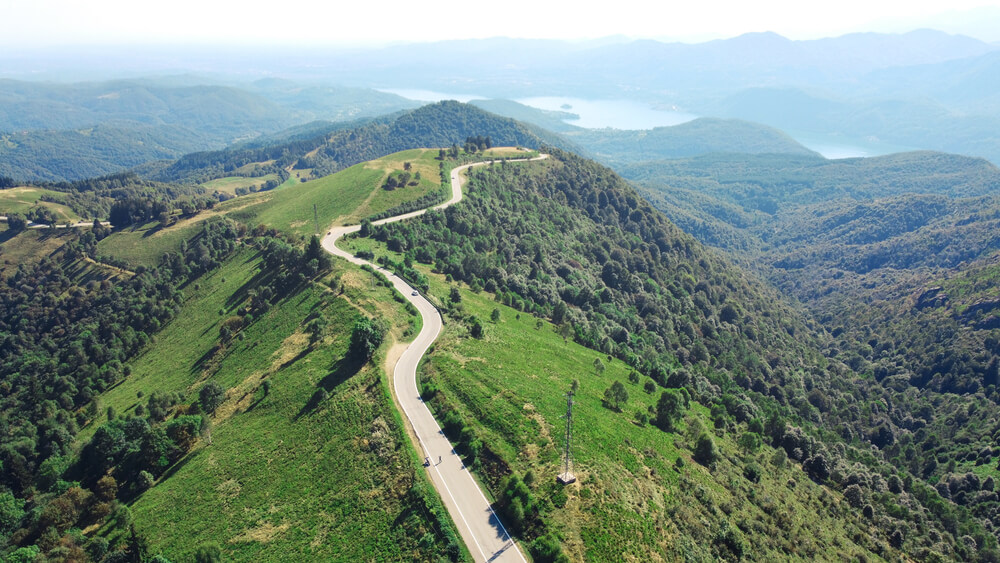
Many of the walking routes provide a fascinating insight into the history of the region. As an example, a number pass through First World War defence lines so it’s not unusual to come across the remains of a trench, cave lookouts, artillery positions, military mule tracks, logistical structures, tunnels or even barracks. Other walks may take you through vineyards such as those on Lake Iseo through the Franciacorta wineries. Others pass by waterfalls. Others may incorporate film history. Head for a hike in the valleys that lead down to Lake Maggiore – Valle Maggia and Valle Verzasca – and you can visit the Verzasca Dam which features in the opening sequence of James Bond’s Goldeneye for example. What is certain is that what connects all will be the most idyllic scenery accompanied by the most incredible views.
There are routes for all abilities too. Some of the most demanding may involve the climb from the lakeside up the surrounding hillsides. However, for those looking to reach the summit with a little less exertion, a number of cable cars or funiculars provide transport from the lakeside up to the top of the hills from where you can start your hike. The views over the lakes are incredible from here and marked paths will lead you through the magnificent countryside.
Some of these cable cars include the affectionately named ‘bucket lifts’ in Laveno and both the funicular, Cardada cable car and chairlift at Locarno. On Lake Como, you have the Como-Brunate funicular. There are also two cable cars on Lake Como. The first is the Piani d’Erna Cable car near Lecco. The second is the cable car from Argegno to Pigra. In just 5 minutes, it will take you from 200 metres to 850 metres above sea level – the views at the summit and en route are spectacular. On Lake Garda, you have perhaps the most impressive of all – the rotating cable car that goes from Malcesine to the top of Monte Baldo. And on Lake Lugano you have the Monte San Salvatore funicular.
Sadly, there was a tragic incident in May 2021 on the cable car that once took visitors up from Stresa to the Mottarone mountain. It has been closed ever since. However, if you do want to drive up to the summit, there are also some wonderful walks on the Mottarone on Lake Maggiore. Here you can see all seven lakes on a clear day.
Of course, you don’t need to catch a ride in a funicular or a cable car to enjoy some great hikes. You will see clearly marked trails from many of the lakeside towns and villages in the Italian Lakes. The breath-taking scenery and variety of terrain makes the Italian Lakes one of the best areas in Italy, if not Europe, to enjoy hiking.
Cycling
In the same way as the countryside around the Italian Lakes is great for walking, it’s just as good for cyclists too. The mountains surrounding the Italian Lakes have special tracks for mountain bikes, whilst, in the main, the roads that lead around the lakeside are relatively flat and perfect for road bikes.
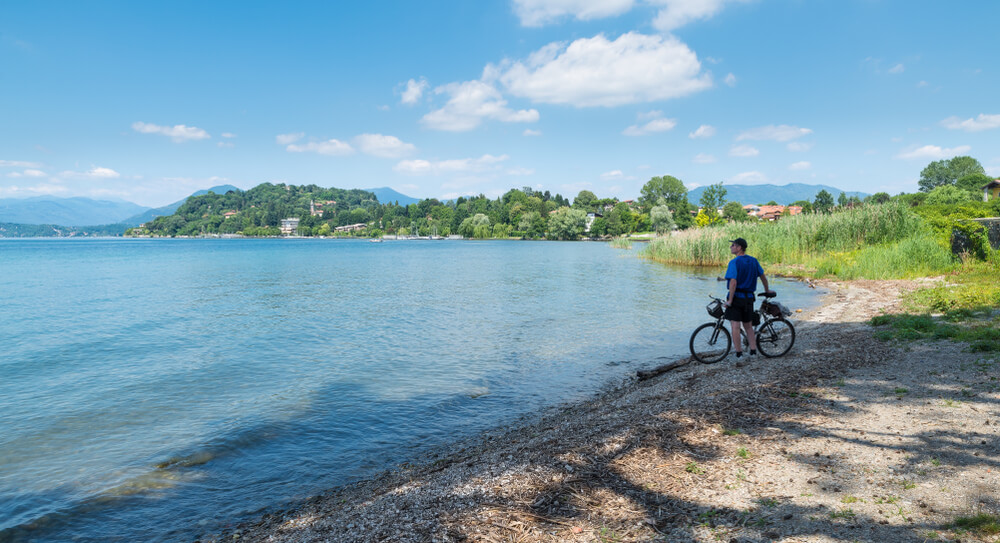
It would certainly be easy to cycle all the way around some of the lakes. The circumference of Lake Orta is just under 34 km and Lake Lugano 67 km. Even the circumference of Italy’s largest lake – Lake Garda – is only 160 km. In fact, a Garda by Bike project is finalising a continuous 140 km pathway that will take cyclists all the way around the lake. The already completed suspended path at Limone is amazing. Whilst not quite finished, don’t let that put you off. You can easily connect between pathways.
Best Places to Visit in the Italian Lakes
We would argue that some of the best places to visit in the Italian Lakes are its hidden gems. However, we appreciate that there are also a number of bucket list sights that simply have to be ticked off for you to have fully discovered the region. For us, these attractions are those bucket list places…
Milan
Milan sits less than 60 km from both Lake Como and Lake Maggiore. It is home to an iconic cathedral – the Duomo – as well as the beautiful Galleria Vittorio Emanuele II shopping arcade, the prestigious Teatro alla Scala opera house as well as the historic Sforzesco Castle and neighbouring Sempione Park. It is also where you will find one of Italy’s UNESCO World Heritage sites – the Santa Maria dell Grazie – which is home to Leonardo da Vinci’s painting of The Last Supper.
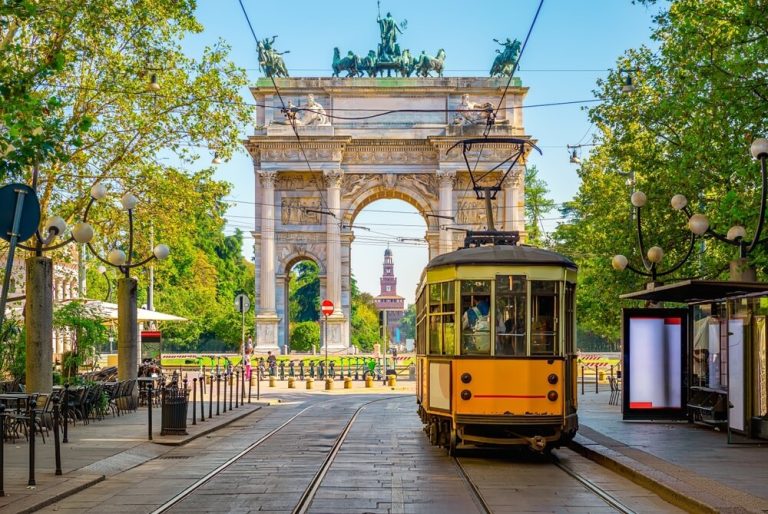
Verona
One of Italy’s many UNESCO World Heritage sites, Verona is home to one of the richest collections of Roman remains in Northern Italy. It is a beautiful and historic city with a wealth of attractions to visit. These include the incredibly well preserved Arena di Verona, Juliet’s House with its famous balcony and the enchanting Piazza delle Erbe and Piazza dei Signori.
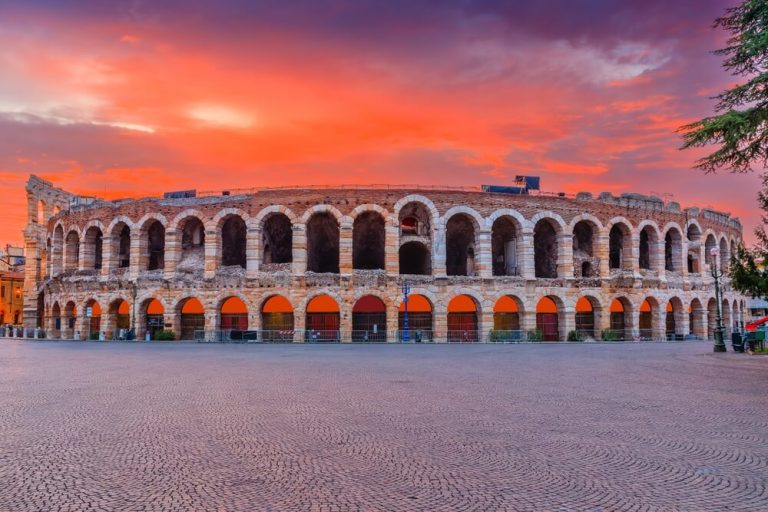
Borromean Islands
Nestled just off shore from Stresa on Lake Maggiore, the Borromean Islands are made up of Isola Bella, Isola Madre and Isola dei Pescatori. The latter is the only inhabited island but is where you will enjoy some of the best fish dishes anywhere on the lake. Isola Bella is home to the beautiful Palazzo and its gardens which are in turn home to the famous white peacocks. Visitors can not enter the house on Isola Madre but the gardens are open to the public and are also well worth a visit.
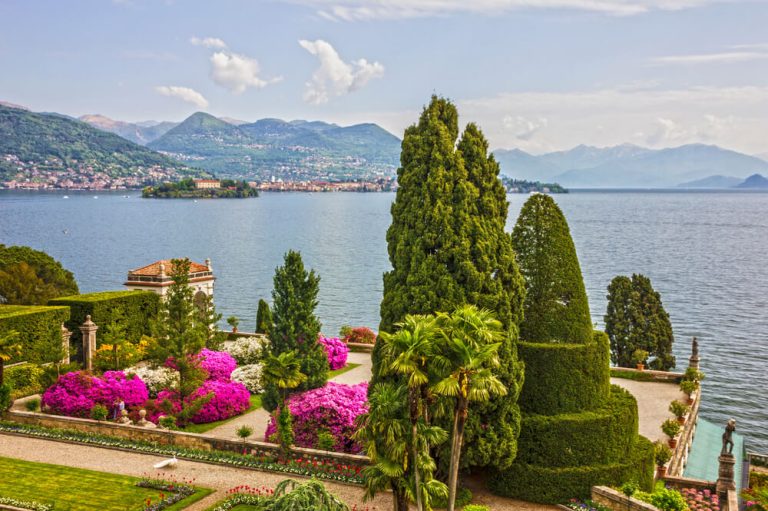
Santa Caterina del Sasso
Reached either by road or by boat during the summer months, this is a hermitage clinging to the rocks on Lake Maggiore. So the story goes, the hermitage was founded by Alberto Besozzi. He was a rich local merchant who, having survived a heavy storm while crossing the lake, then retreated to this rocky ledge to live the life of a hermit. These days the monastery is under the care of Benedictine monks. It is home to beautiful well-preserved frescoes dating from the XIVth to the XVlllth century.
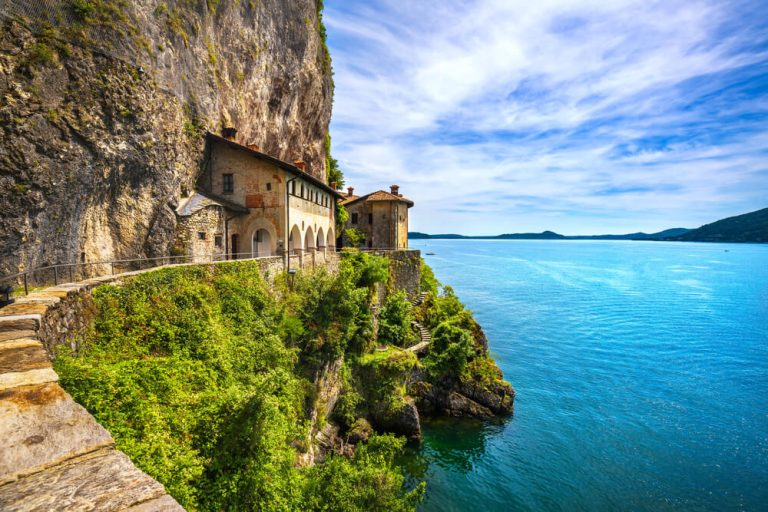
Villas on Lake Como
Whilst most of the Italian Lakes are home to historic villas, those on Lake Como are the most famous. Here, many of them are open to the public and offer a glimpse into aristocratic life over the centuries. Villa del Balbianello near Lenno is arguably the most iconic. It is famous for its terraced gardens and has been the backdrop to numerous films including Star Wars and James Bond. Also of note though is Villa Carlotta in Tremezzo. Here the botanical gardens outdoors are as spectacular as the art collection indoors. And near Bellagio there is Villa Melzi with its serene lakeside gardens and stunning neoclassical architecture.
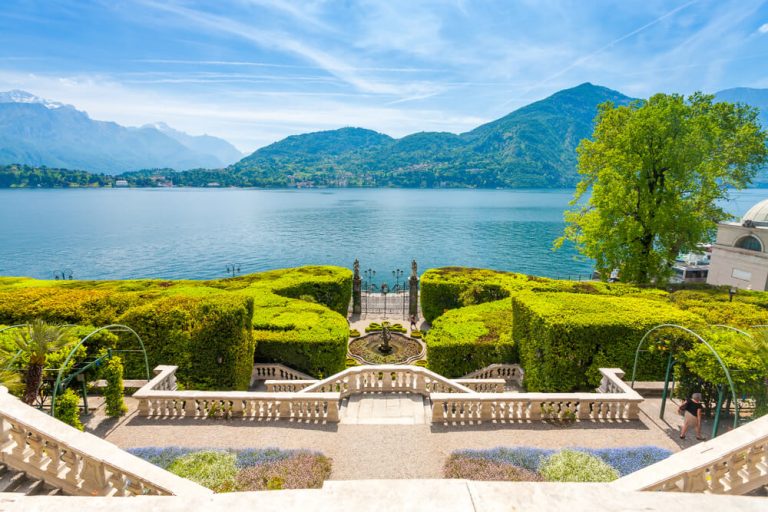
Vineyards of Lake Garda
The vineyards and olive groves around Lake Garda are idyllic. The region is famous for producing some of Italy’s most renowned wines, including reds such as Amarone and Bardolino and whites such as Lugana. Visit one of the many family-run wineries or olive farms, enjoy a walk among the vines and trees before enjoying a tasting accompanied with local food pairings.
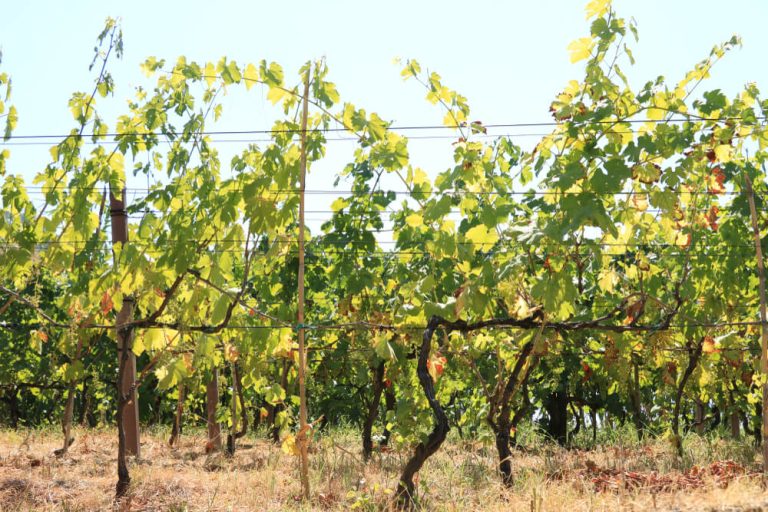
What to Eat and Drink in the Italian Lakes
As you can would expect from any of Italy’s regions, the Italian Lakes serves up the most delicious food. The area sits in a number of different regions of Italy – Lombardy, Veneto, Trentino and Piedmont – and all bring their own influences and culinary traditions. There are plenty of regional specialities we recommend you trying during your Italian Lakes villa holiday.
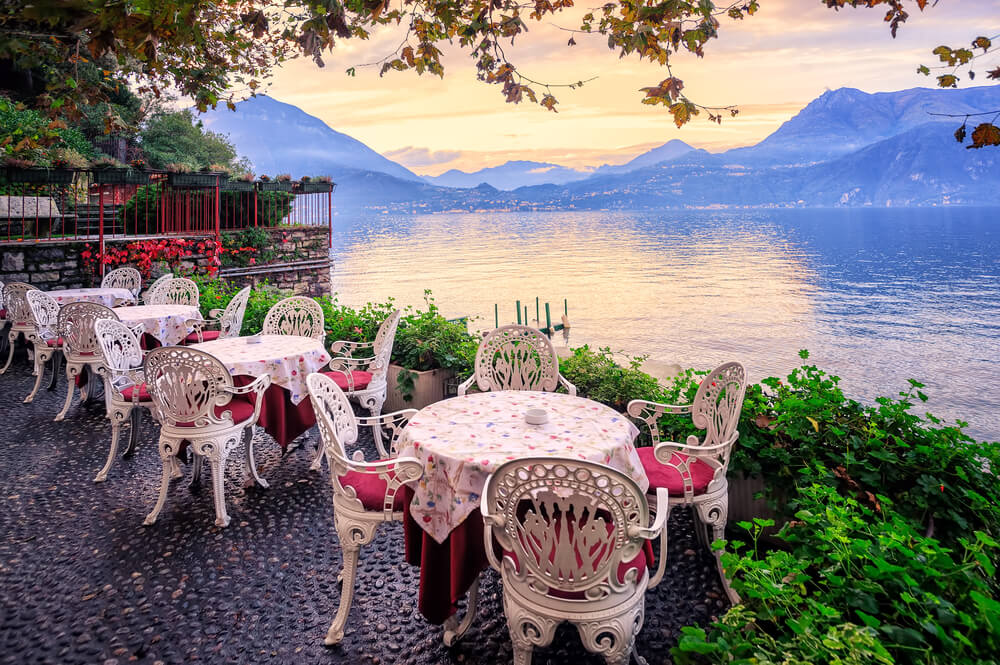
Fish
It is probably not surprising to discover that many of the local specialities are fish dishes. The lake waters are home to a large variety of fish. The most popular varieties used in cooking are the trout and perch, however there are also whitefish, trout and others. These are usually served with herbs. However, for something more unusual, opt to try the sun-dried fish of Lake Como – missoltini – or a dish called Pesce in Carpione. This is a dish usually served cold and can be enjoyed either as a starter or main course.
Or on Lake Garda, try the Bigoli con le Sarde. This is a traditional Venetian dish that combines pasta with fresh lake sardines and extra virgin olive oil. Or instead sample the Risotto con la tinca. This is a traditional risotto that uses tench.
Meat
On Lake Garda, look out for Tortellini di Valeggio sul Mincio. This is filled pasta served in a meat broth made using Bardolino.
In the mountains around Lake Como and Lake Maggiore, salted meats are popular. Sausages are often flavoured with wild mushrooms or rabbit. In the Ossola Valley, near Lake Maggiore, viulin is a dish that comprises the leg of a goat stuffed with herbs and spices. Not far away in Val Vegozzo, Santa Maria Maggiore is famous for its smoked ham. Or on Lake Como look out for casoeula in restaurants. This delicious dish combines pork and cabbage.
Cheese
A number of dishes you find in the Italian Lakes also use local cheese. La Carbonera is a traditional dish historically eaten by poor charcoal makers. It consists of polenta, Monte Baldo cheese and extra virgin olive oil. It is most common in the north of Lake Garda. On Lake Como, local cheeses include Ricotta del Lario, Nostrano, Semuda, Magra di Bellagio and more. It is often used quite simply combined with polenta and butter to create polenta uncia. On Lake Orta, look out for the Gnocchi di patate con Gorgonzola e noci on restaurant menus. And finally on Lake Maggiore enjoy the mild tasting Ossolano d’Alpe, Bettelmatt and yellow coloured Mottarone cheeses. We love these best on their own or dipped into some local honey. These are usually made on the high mountain pastures. But cheeses are also made lower down on the lake shores too. For example, the Formagello of Luino is a firm goat’s cheese.
Bread
Fun fact: Ciabatta bread originated in the Como area. You can still enjoy it today along with other bread specialities. These include Miascia (bread cake), Braschin (sweet focaccia), Pan de Mej (sweet focaccia with elderflower). Other sweet treats made using local flour include Resta (and Easter cake) and Pan Matalach. This is found in Bellagio and is similar to a panettone.
Olive Oil
Garda DOP extra virgin olive oil must be tried on any Lake Garda visit. Whilst not as well known, Lake Como also has olive trees on the hilly terrain around the lake ever since ancient Greek and Roman times. Olio dei Laghi Lombardi has
Desserts and sweet treats
Our favourite sweet treat is the Cassata Gardesana made using ricotta, honey and candied fruit. However a close second is the Margheritine of Stresa. And most people agree that Panettone originated in Milan.
Wine
The slopes around Lake Garda are not just planted with olive trees. They are also home to a number of wineries. Wash all this delicious food down with a glass of red – Bardolino Classico and Superiore, Amarone, Valpolicella or Groppello . Alternatively, opt for the rose wine – Bardolino Chiaretto – or one of the local whites – Custozo or Lugana. Wines are also often used in cooking too. The Risotto all’ Amarone is a risotto made using Valpolicella wine as well as local Monte Veronese cheese.
Part of Lake Maggiore’s shores also fall into Piedmont This is prime wine making country. And you can also enjoy Nebbiolo from the Novara hills.
The upper area of Lake Como is also a wine producing area. Here white wines using Chardonnay, Riesling and Verdese grapes whilst reds use Barbera, Merlot and Cabernet Sauvignon amongst others.
The Best Time to Visit the Italian Lakes
There is no bad time to visit the Italian Lakes! Instead, think about the best time to visit based on your interests.
However, our favourite time of year is certainly the Summer, perhaps not least because our visits then have created so many happy family memories.
Summers in the Italian Lakes tend to be dry and hot. However, the lakes create their own micro climate – they warm the area in the Winter months and take the edge off the heat in the height of the Summer. This means the region tends to escape the stifling humidity you can see further south in Italy. Certainly, Summer can be a great time to visit if you want to combine lazy days sunbathing at the lakeside lidos with exploring the lakeside towns and villages. However, don’t expect completely dry weather. It can rain, although in the Summer months the rainfall tends to be at night – the thunderstorms then can be pretty dramatic and make for some great weather watching.
That said, some of the lakes, particularly Lake Como and Lake Garda, can get extremely busy in the peak Summer months. Expect to find driving slow along Como’s narrow lakeside roads and be prepared to book activities well in advance to ensure you don’t miss out.
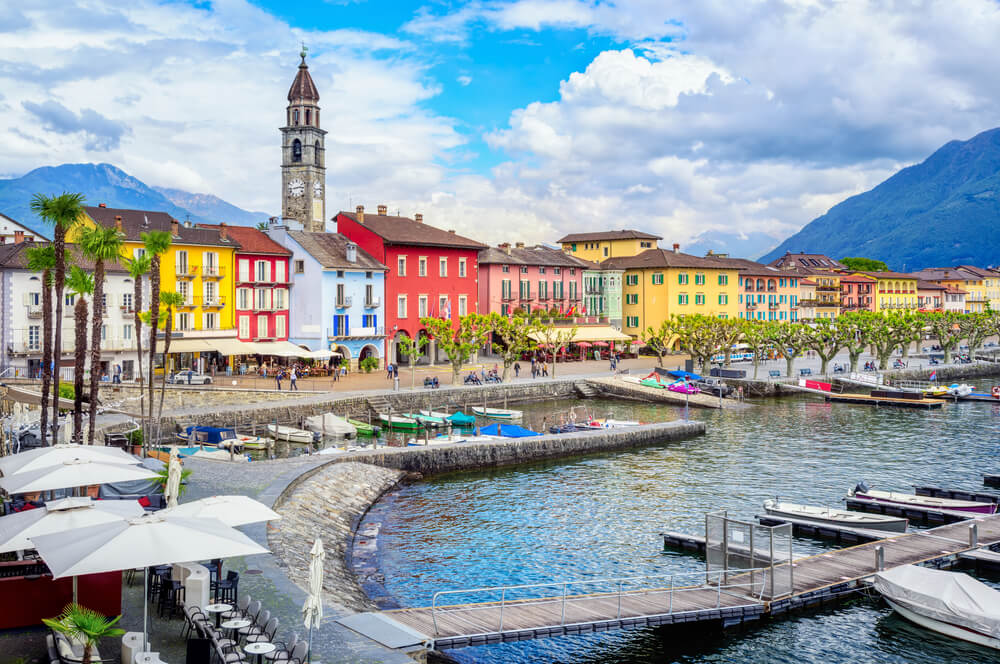
As a result, those preferring to avoid the crowds might want to consider visiting in the late Spring or early Autumn instead. Late Spring is certainly when you can expect the lakes to be at their most colourful. The wisteria and camelia will be in full floom in April and May. However, if you plan to be swimming in the lake, expect to find lake waters on the distinctly chilly side. We’ve been known to take a dip in early April but it’s not a time for the feint hearted to take the plunge!
Lake temperatures average 10 degrees centigrade in April, warming up nicely to 24 in July and August. And in September temperatures remain a very pleasant 20 or more degrees.
Don’t rule out visiting the Italian Lakes in the off -season Winter months. There is something particularly charming about this region when all the tourists have gone home. However, we advise you choose your destination carefully if doing so. Many businesses in some of the most popular lakeside towns such as Bellagio will close in the Winter months. Choose an authentic town which has a strong local population.
Visitors should also be aware that the public boat system is. As a result, you should be prepared to find yourself driving between sites a lot more during the Winter months.
How many days do you need in the Italian Lakes?
At Bookings For You, we’re super happy to create a bespoke itinerary for your Italian Lakes villa holiday. An itinerary will inevitably vary dependent on the location of your Italian Lakes villa in and whether this is your first visit or whether you’re returning seasoned holidaymakers. We’re always in favour of ‘slow travel’. By that we mean not rushing around trying to tick everything off on one trip. It’s about embracing a more sedate, leisurely pace. It’s a way of exploring an area at a deeper level, prioritising quality experiences over quantity. It’s also about connecting with locals so that you leave with a deeper understanding of their culture, instead of just focusing on the main tourist hotspots.
3 Days in the Italian Lakes
If you have just 3 days in the Italian Lakes, we recommend you choose just one lake and focus your attentions there rather than moving between lakes. In many respects, it doesn’t matter too much where you choose to base yourself on your chosen lake as it’s so easy to explore.
5 Days in the Italian Lakes
If spending 5 days in the Italian Lakes, there are numerous itineraries you could choose from, but let’s just say you chose Lake Maggiore as your base. You could spend day 1 visiting the beautiful Borromeo Islands. Trying to visit all 3 of these islands in a day is going to be difficult but not impossible, especially if you opt for a private driver so you’re not dependent on the public boat timetable. Day 2 could be spent exploring one of the lakeside towns before heading to the beautiful Santa Caterina del Sasso in the afternoon. Day 3 could be spent exploring another of the lakeside towns before heading to one of the lakeside beaches or lidos in the afternoon for some rest and relaxation. Day 4 might then be an opportunity to enjoy some water sports or a chance to use the boat system to discover more of the charming lakeside towns and villages. Our ‘must see’ towns on Lake Maggiore include Arona, Ascona, Cannero, Canobbio, Luino, Pallanza and Stresa so you can easily see how, even in 5 days, you’re not going to be able to tick everything off your list. And day 5 could be a chance to enjoy a hike in the beautiful countryside and hillsides that surround the lake. Why not head up the bucket lifts in Laveno to reach the beautiful countryside at its summit and to enjoy the breath-taking views. Or explore the wonderful hikes in the hills behind Cannobio.
Alternatively, you could opt to spend days 1, 2 and 3 exploring your first choice of lake and then you can consider moving across to explore another lake for your last couple of days.
If choosing Lake Maggiore for your primary destination, then it can take as little as 15 minutes to drive from here to Lake Orta, or as little as 50 minutes to reach Lake Como on the other side so certainly a 5 day twin centre stay is easily possible. Lake Garda is a longer drive. However, if you opted for Lake Garda for your first 3 days, then you can still reach Lake Como and Lake Maggiore by car in under 2 hours.
That said, the proximity of the lakes to one another is just as much an argument for sticking with a single base and enjoying day trips to the other lakes if you want to explore further afield.
In this case, if you have just a single day on a lake and only have the opportunity to do one thing, these would be our priorities. On Lake Maggiore, for us it would be to visit the Borromean Islands. On Lake Como it would be a trip to Bellagio and Varenna. On Lake Garda it would be to wander around the lakeside towns of Sirmione, Riva del Garda or Malcesine, and on Lake Orta it would a trip to Orta San Giulio and its nearby island.
10 Days in the Italian Lakes
If you are lucky enough to have 10 days in the Italian Lakes, then you may actually still choose a single base and enjoy a slower pace of travel. However, if you are keen to explore more, then a 10 night stay allows you the option of a twin centre stay with 5 nights on Lake Garda and 5 nights on either Lake Como, Lake Maggiore or another of the lakes.
Our very first trip to the Italian Lakes region was back in 2003. Back then we opted for 5 nights on Lake Como before heading to neighbouring Lake Maggiore for 5 nights. This worked extremely well and meant we could get a good feel for both.
14 Days in the Italian Lakes
If you can spare the time, then a 2 week stay in the Italian Lakes allows you to see all the sights in a 10 night stay but again enjoy the Italian Lakes at a slower pace. Stop en route as you drive from A to B, allowing you the opportunity to discover some of the smaller towns and villages on the lakeside. And make sure you take time to just relax and enjoy your chosen Italian Lakes villa rental. Visit the local markets and enjoy some experiences. Spending time with the locals is the best way to bring the region to life.
A month in the Italian Lakes
In reality, given the sheer size of the Italian Lakes, you would need at least a month here to do it justice. A month allows you ample time to properly explore each of the main lakes – Lake Garda, Lake Como and Lake Maggiore – whilst even being able to discover some of the smaller, less well-known lakes too such as Lake Orta or Lake Monate. We recommend having no more than 2 or 3 bases at most and then doing day trips from these bases.
Italian Lakes villa holidays for...
An Italian Lakes villa holiday is one that is suited to all. There is so much to see and do in the Italian Lakes that we’re confident that whatever your tastes and interests, you will find plenty in the Italian Lakes to enjoy.
For Couples
If you’re looking for a romantic break for two in Italy, we highly recommend Lake Como or Lake Orta. If you’re after romance with the crowds, then Lake Orta ia one of the quietest and most tranquil of the Italian Lakes. Enjoy a day exploring the beautiful lakeside village of Orta San Giulio before taking the short 5 minute boat ride to Isola San Giulio that sits just off its shores. Silence prevails on the island and as you enjoy the short walk that takes you around its perimeter, signs remind you of the power of silence through inspirational quotes.
That said, if you’re looking for a bit of glamour to add to your romantic holiday, then Lake Como is a great option. George Clooney’s decision to buy a house on Lake Como added to the showbiz appeal that Como already had thanks to its use for scenes in James Bond’s Casino Royale. And there is surely nothing more romantic than a stroll through the magnificent gardens of Lake Como’s Belle Epoque villas. Although, it has to be said, a private boat ride to the Borromean Islands on Lake Maggiore would give Lake Como a run for its money in the romance stakes!
And you shouldn’t rule out Lake Garda either. Whilst much of Lake Garda is busier and more bustling, there are numerous charming lakeside towns and villages on its shores which could be the perfect base for a romantic getaway. Lake Garda is also the closest Italian lake to Verona, the home of the star-crossed lovers. Why not join the other couples who visit Romeo and Juliet’s balcony each year to leave a padlock attached to the gates or to leave a love letter in the cracks of the walls. It is a beautiful city to explore hand in hand with a loved one.
For Families
If visiting the Italian Lakes with children in tow, our definite recommendation is to visit Lake Maggiore. When we first visited the Italian Lakes prior to setting up Bookings For You, we spent a week on Lake Como and a week on Lake Maggiore. It was the latter that won over our hearts and which we felt was truly family friendly. Numerous family holidays and business trips later, our views haven’t changed.
Lake Como’s beauty is dramatic, with hillsides and mountains rising seemingly straight out of the water. However, this does have its drawbacks for family holidays. For one thing, Lake Como’s beaches tend to be less easily accessible. There are fewer of them, and many of those that do exist are private and owned by the grand villas that line the lake shores. Even when thinking about the things to do on Lake Como, there is much less geared to children and much more to adults.
In contrast, Lake Maggiore is super family friendly and there is an abundance of things to do for children and teens These include a vast array of water sports – pedaloes and paddleboards are perfect for all ages whilst water-skiing and windsurfing are on offer for children approaching the end of primary school and up. Not only that, there are a plethora of beaches and some great lidos that not only provide access to the lake but also have waterslides and inflatable assault courses! Go-karting, ziplines and tree-top adventure courses complete the line-up. We think that combining some child friendly excursions like these with activities that the grown-ups will enjoy is the recipe for a perfect Italian Lakes holiday!
Our second choice after Lake Maggiore for families would be Lake Garda. Whilst we aren’t such fans of the greater number of tourists in parts of Lake Garda, the lake is home to Gardaland which attracts thousands of families each year.
Solo Travellers
If travelling solo, we recommend choosing a lakeside location, that provides you with good public transport links and easy access to the boat network. Whilst driving in the Italian Lakes is easy most of the time, it can still be stressful if driving on your own. As a result, we think it’s much more relaxing to explore the area by boat (or using the other public transport links available).
Alternatively, if you’re looking to meet others during your travels, choosing one of the larger towns or cities in the Italian Lakes can be a great option. Como is a nice sized city. It’s not too big or daunting but big enough to easily connect with fellow travellers and experience the city’s culture as part of a larger group
For Groups
We think that renting a large villa in the Italian Lakes is a great option for groups. You’ll be able to enjoy the privacy and space that a self-catering villa offers. If part of a larger group, we recommend opting for one of the larger lakes – Lake Como, Lake Garda or Lake Maggiore.




